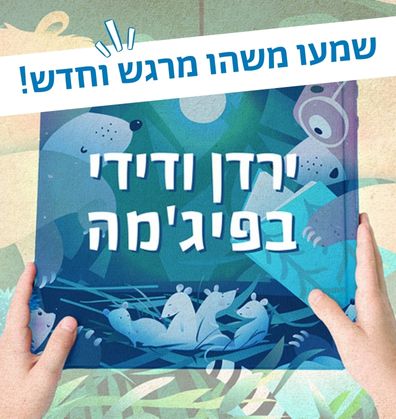מְקוֹרוֹת וְתַרְבּוּת
קלאסיקה ישראלית
ארון הספרים הישראלי שופע בספרות עברית יפה שלא נס ליחה ועוברת כלפיד מאיר מדור לדור, מאירה את ימינו ואת חיינו, ומעצבת את הריח ואת הטעם של הילדות הישראלית. אתם מוזמנים ליהנות ממיטב ספרי קלאסיקה ישראלית שיצאו בספריית פיג'מה, ומחכים רק לכם!
סְּפָרִים
Book-Related Family Activities

Family reading advice
Simple rhyming stories can convey a value-based, meaningful message too. We recommend using the story as a basis for discussion, allowing for opinions to be expressed and questions asked, such as “How would you have felt if you had been in a similar situation?”

“… And happiness shall be yours!”
Grandpa is happy to return home with his stars, calling them his treasure, and valuing them more than money. Following this story, you can discuss with your child and ask: “What makes you happy that money cannot buy?” Drawing? Bedtime stories? Perhaps a good-morning hug? Parents can also share – what is their treasures?
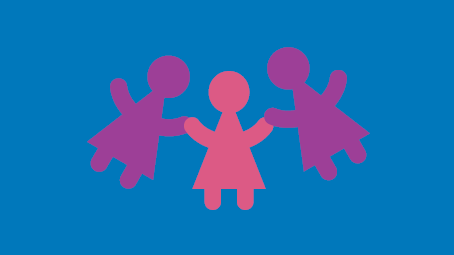
Our tree
If you were to have your very own imaginary tree – what would it grow? Hearts? Balloons? Perhaps stars too? You can draw and cut out the shape you have imagined, decorate it, and even write wishes or shared memories on it. The finished product can then be hung on a plant, branch, or tree near you.

Starwatching
We may not find a real star tree, but we can always take an evening stroll and enjoy the sight of the stars twinkling in the sky. You can take this book along with you and read it together by starlight.

QR code
Poet Leyb Morgentoy, 1905–1979, was born in Pinsk, Poland. He wrote this poem in Yiddish in 1938. Yoram Taharlev translated it, Nurit Hirsh composed music to it, and, in 1969, Chava Alberstein performed and recorded it.
Scan the QR code to listen to the song:

Family reading advice
A song that has been turned into an illustrated book gives readers the opportunity to experience it differently, understand it anew, or refamiliarize themselves with it. Therefore, when reading such books for the first time, try not to be tempted to “sing the book”, but instead to read it as you would any other story.
The wonderful children’s author and poet Ayin Hillel (1926–1990) was born and raised in Kibbutz Mishmar HaEmek. Although he was a landscape architect by profession, more than anything else he enjoyed writing poems for all ages. David Polonsky is among the most prolific Israeli illustrators. Internationally renowned, he has illustrated well-known children’s books, created film animation, held numerous exhibitions, and is the recipient of many awards.

Time goes by
Questions stimulate discussion and thinking. You can look at the illustrations in this book and ask: What is the boy doing on each page? What does he look like in the beginning of the book? And what does he look like at the end? You can be inspired by the illustrations to look at old pictures of yourself, seeing how you have grown, and ask questions – What was I doing when I was one year old? And what am I doing now? What have I discovered and learned since then?

What do they do?
What does a washing machine do? And what does the ceiling do? Following this book, you can walk around your home or outdoors, and ask questions about the things you see around you: “What do they do?”

Discovering the world
This book asks many questions and gives a range of amusing answers to them. It invites you and your child too to explore and discover together; you can ask your child – What else do trees do? What else do clouds do? You can even make your own book of questions & answers. Write them down and add some illustrations. Any time a new question comes up, you can add it to your book, and look for the answer.

QR Code
The music for Ayin Hillel’s well-known and well-loved song was composed by Naomi Shemer, and has since become an Israeli classic. Scan the QR code to listen to it.

Who am I?
“You mimic animals so much that you don’t know how to mimic yourself”, says Shumdi to Arik the lion. You can discuss the things that make each of you special: your voice, body movements, hobbies, favorite food – and what else?

Mimic & guess
Much like Shumdi and Arik, you can also take turns making animal sounds, and having your family guess which animal you were trying to mimic. You can also add the sounds made by objects, and try to mimic the sounds of rain, wind, or any mode of transportation. You can record the sounds you make too, listen to them one at a time, and try to guess which of your family members made it.
Favorite stories
Anat especially likes the stories told by Shumdi the rabbit. Which stories are your personal favorites? You can look for and recall stories that the kids liked when they were infants, as well as well-loved stories that you have not read in a while, put them all together, and read one of your favorite stories whenever you feel like it.
Family reading advice – The recurring phrase
Many books for toddlers have a recurring phrase that helps them follow the storyline and play a part in the reading. To emphasize the recurring phrase while reading this book, you can use a special voice, add a hand gesture, or change your reading pace. When the familiar phrase comes up, your toddlers will be delighted to join you.
Ora Ayal [1946-2011] was a children’s writer and illustrator. She illustrated over 70 books, among them Miriam Roth’s well-known books, as well as writing some herself, such as A Girl Alone and One Dark Night.

Discussion – Who do we love visiting?
Visits are a significant part of a toddler’s world. We visit family and friends, and sometimes, they visit us. You can discuss and ask: Who did we visit? What did we do during our visit? Who shall we invite over to our house?

Who will we meet next?
At the corner of each page there is an illustration that hints at the encounter we will see on the following page. Before you turn the page, you may want to look at the illustrated clue and guess who will be waiting for you on the following page. You can even play with real-life objects: Cover an item almost entirely, and ask your toddler what is hiding under the cover – a teddy-bear? Hat? Or purse?

What is in the illustration?
The final page of the book is a story in itself, containing many illustrated details. You may enjoy looking for the many details in the illustrations that you have come across throughout the book: a dog, girl, hat or flower. You can even try to identify and name the items at Grandma’s house: Where is the kettle? What is hanging on the wall?

Reading advice: Befriending a book
Reading books from a young age contributes greatly to toddlers’ development. Starting to read slowly and gradually is recommended. At first, toddlers may be allowed to connect to the book in their own way: Touch it, open and close it, look at the illustrations, and become curious. Later, you can read: Read a little each day, patiently and calmly. Some toddlers will prefer to be read a single page, get familiar with it until – hey – books have become their friends!
What happens along the way
We can make interesting discoveries if we only pay a little attention. You may enjoy discussing what you see as you walk or take a drive: “Here is a red car!” “I see clouds. What do you see?” You can also share experiences with your toddler: “On my way to work today, I saw a lady walking her dog. What did you see on your way or back from daycare?”
Why read with toddlers?
Scan the QR code to discover how books’ contribute to toddlers’ development.

Morning ritual
Like the boy in the book, all toddlers enjoy rituals that generate a fixed routine, calm them down, and help them start their day feeling good and happy. You can also have your own morning ritual. For example, you can encourage your toddler to say good-bye a beloved stuffed toy: “Teddy, Teddy, I’m going to Kindergarten, goodbye!”, while you parents reply on behalf of the bear: “Goodbye! See you later! Have a safe journey!”

Encountering animals
Many animals appear in the book. You can look at them together, and state their names, make the relevant sounds, and mimic their movements: Crow like a rooster, hop like a bunny, or gallop and neigh like a horse. You can also look at the illustrations on the final page, cover one of the animals each time, make the relevant sound or mimic its movements, and have your toddler guess which animal it is.
A tip for family reading
When reading a songbook, you can focus on one song at a time, read it several times, or sing it, if it has a tune. Try looking at the drawings together, and note where the toddler’s attention is drawn. Every so often, you can add another song from the book and see what reactions it evokes, and whether it’s fun and intriguing.
Other animals and us
You will encounter various animals in the book. The toddlers will know some of them. Others will be new and exhilarating. Whenever you encounter animals nearby, you can draw the toddler’s attention to what’s special about the animal – “the bird has a beak”, “the ants march in a line”, or “the snail carries its house on its back”.
Singing with your whole body
You can use gestures as you sing. For example, when you sing “Come, Little Butterfly”, you can invite the butterfly with a beckoning gesture, flap your hands, and tap on the toddler’s hand. Which gesture would you use for a monkey cracking up? Or a bear climbing a ladder?
Inside my closet
A shirt? A swimsuit? Perhaps a dress? How about taking a look inside your closet, finding clothes you like, and saying when you usually wear them: Winter clothes, summer clothes, fancy clothes for special occasions, and all-time favorite clothes.
Singing & dancing with the zebra
The verses of Why is the Zebra Wearing Pajamas? have been set to music and turned into a beloved children’s song. You may enjoy scanning the QR code, and proceed to sing and dance together.
Illustrations – Zebra & friends
The zebra’s friends feature in the book’s illustrations: You could leaf through them together, find the various friends, name the animals together, and introduce them. Next, you could say the name of an animal you know, and then look for it in among the illustrations contained in this book.
Playing Hide and Seek
Let’s play hide and seek! We can hide our fingers in the palm of our hands, cover our nose and reveal it, hole up under a blanket, conceal ourselves behind the couch, or hide a toy behind our backs.
Who wants to go first?
Seek Out the Cat
Meow! The grey kitten has joined our game of hide and seek. You can search for it every illustration, just be careful not to step on its tail…
Some Reading Advice: How to Turn Books into Friends?
Reading from an early age plays a key role in toddler development; however, like anything new, the question is – how do we find the way? We suggest getting acquainted slowly and gradually; let the toddler connect to the book in their own way: Touching, opening and closing, and even “tasting” it with their mouths. Afterwards, you can read: A little each day, patiently and with pleasure. At first you could even read a single page, introducing it and getting accustomed to it, and hey presto – you have turned a book into a friend!
Sifriyat Pijama an opportunity to read together, at any age
Identifying and indicating
Here’s the sea! Here’s a mountain! And a butterfly too! As toddlers grow, they enjoy pointing at everything they recognize in the illustrations. You could pause on each page, take a look together, and discover what your toddlers already know. You could ask them to indicate where the rabbit is, and, if they struggle, look for it together.

From the book to the outside world
You could continue the journey that began in the book with a game at home, played while kneeling, saying “choo choo” and adding the hand gesture, or on the rug with some toys. You may enjoy looking out of the window together, seeing what is going on outside, and saying: “There’s a traffic light! Here’s a tree! And what else can you see?”

Some reading advice: How do voices and facial expressions help when reading?
Toddlers are fascinated by the tone of voice, facial expressions, sounds and gestures of the person who is reading to them: All of these help them follow the story, enjoy and understand it. Allow yourselves to be actors for a few minutes. You have won the best audience, who is sure to appreciate and enjoy your unique reading style.
A discussion on who is wisest
Perhaps you would enjoy discussing and sharing the following: What do you think makes a person wise? Can you think of an incident in which someone behaved wisely? Was the fox wise, or the rooster? Perhaps they bother were? Or maybe neither one was?
Five facts about Levin Kipnis
What did Levin Kipnis do when he was growing up? What did he have to do with comics? Go ahead and scan the QR code, and watch the video to find out.
A game of “What actually happened?”
Having read this book together, you, parents, may want to tell a story, and ask the others to decide whether the story you’ve told actually happened or was a work of fiction. Next, ask your children to share their own stories. This may be a good opportunity to share unusual incidents with one another, and laugh together.
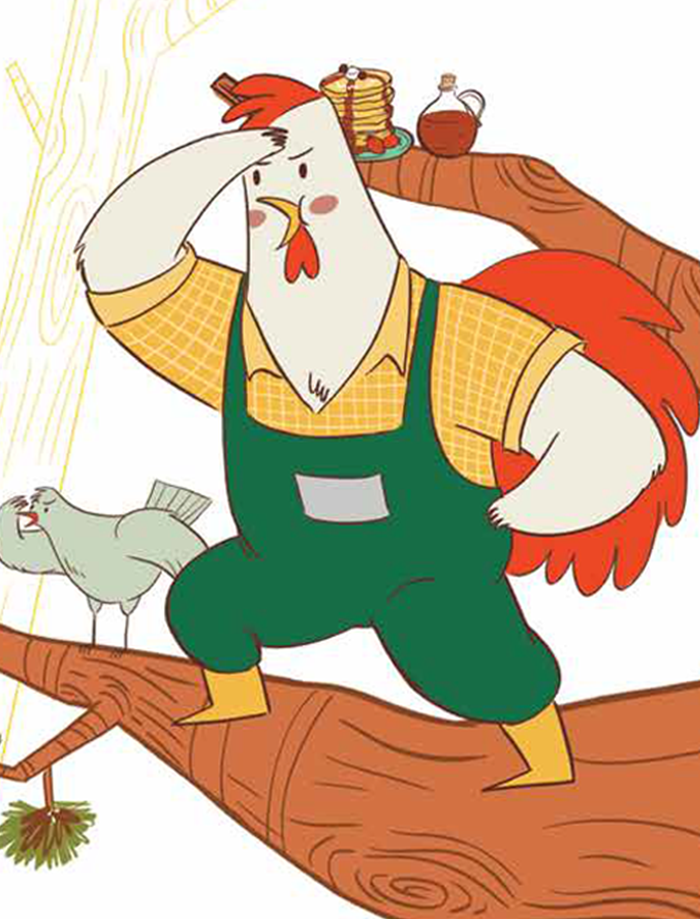
Ram-Kol and other names
What does the name Ram-Kol (Loud-Speaker) tell us about the rooster? Can you come up with names for yourselves that reflect a special, good quality that characterizes you? Perhaps the rest of your family can help!
Reading a poetry book
Books of poetry tell small stories from a children’s world of imagination, emotion and experience. You can choose in which order to read the poems or not even read all of them. You can choose to read a poem because of an intriguing illustration, an interesting title, or because it suited your mood. You can decide to read just one poem at a time, or skip ahead. You may enjoy discussing the poem: Did you like it and why?
Pleased to meet you – Nahum Gutman
He painted Israel in bright colors and told children’s stories in words and illustrations. If you scan the QR code, you will be able to discover Nahum Gutman’s books and paintings, and take a virtual tour of the Nahum Gutman Museum in Tel Aviv.
A game of “Which Poem am I?”
Take turns with your family selecting a poem and acting it out without speaking. The other players will try to guess which poem it is. You can also choose one that you all like, and act it out together, or read it out loud while adding matching dance moves.
Paint and tell
There are blank pages at the end of the book which you can use to make your own illustrations and then write stories just like artist Nahum Gutman and authoress Mira Meir did. Perhaps you and your family would enjoy writing a whole series!
A discussion full of delight
Having read this book, you may enjoy a discussion about why, you think, Uncle Simha (Hebrew for joy) is named so. What about the things he does or says that make you smile?
Listening to My Uncle Simha
Would you like to hear a story? Go ahead and scan the QR code to listen to the book My Uncle Simha. You may enjoy listening to it together while turning the pages whenever you like.
Happy songs
Which songs make you happy? Perhaps you could make a playlist of all the songs that make your family happy, and sing along together. You could even sing in funny voices – a high-pitched voice, the deepest of basses, or a whisper – adding some dance moves for greater delight.
A confused game for a confused uncle
Take turns asking a question while the other players try to come up with a “confused” response. For example: What’s your favorite drink? Tea with a touch of mustard! What do you do when it rains? Wear sunscreen! What sound do birds make? Where should we go on our next trip?
Pinterest
Find more inspiration and creative activity in our Pinterest page.
A discussion about my name
Excuse me, what is your name? You may enjoy discussing your names: Why were you, parents, named so? And what has made you choose the names you have chosen for your children? Do you have any nicknames? How did you come by them?
Moving along with Yoyo
Yoyo jumps, sits, climbs… Each illustration depicts Yoyo in a different posture. You may want to act out what Yoyo does, and have the rest of your family members look for the page in the book that shows him in the same position. Were you able to do so? Then it’s time for another member of your family to have a go.
I’m always me – Datia Ben Dor
Are you sometimes happy and at other times sad? So is Datia, who wrote the book, and also wrote the lyrics of the well-known children’s song I’m Always Me, the music of which was composed by Uzzi Hitman. Scan the QR code and sing along!
Arts & crafts – A front door sign
How about getting the following – a cardboard rectangle, crayons, stickers, and some plasticine, if you like – to make a sign for your front door or bedroom door? Write your name at the center of it, color it, decorate it, and hang it on the door! And how about this idea – print out a photograph of yourselves, add it to the sign, and write your names too.
Pinterest
Find more inspiration and creative activity in our Pinterest page
A Discussion on problem-solving
What can we do when we encounter a problem? You may want to share incidents with your children in which you, parents, have encountered a problem. Try to think back to how you felt, think of possible solutions together, and then tell them how you solved the problem.
What can we do with…?
A hoop can be a steering wheel, a plate or… Scan the QR code and watch a video about creativity? Later, you can continue to think about – What can we do with a paper roll? A kerchief? A dwarf puppet?
Singing together
The dwarves planted mushrooms and sang “all the songs they knew”. You too can sing your favorite songs together. Perhaps you’ll sing about dwarves, or rain, or songs that cheer you up and make you smile.
A Game of “Which Dwarf am I?”
Take turns pretending to be one of the dwarves that appear in this book: The one with the umbrella, the one planting a mushroom, or the one jumping into puddles. The other players will try to guess what the dwarf is doing and find it in the book.
Pleased to meet you, I’m Hyla!
I’m similar to a frog but smaller. I can be found in Israel, mostly on trees, eating insects and laying eggs in water. I am a protected species and therefore cannot be kept in a jar – only in nature.
A discussion on searching and finding
Following this book, you may want to embark on searches together with your parents, grandparents, or other relatives: What have you found? Were you surprised? Do you enjoy searching and finding?
A game of Search Cootie Catcher
A game for both seekers and finders.
Scan the QR code
Print out, cut out and fold according to the instructions.
Have you searched? Have you found? Would you like to play again?
Illustrations
This book contains both colorful and black and white illustrations. Can you figure out when the illustrations are in black and white, and when they are multicolored?
A game of “what’s missing?”
A game of “what’s missing?”
Place several items in a row and look closely.
Take turns hiding one of the items while the rest of your family members have their eyes closed. Once it has been removed and hidden, the other players can open their eyes and start searching – Which item is now missing? Where was it hidden?
Pleased to meet you, I’m Hyla!
I’m similar to a frog but smaller. I can be found in Israel, mostly on trees, eating insects and laying eggs in the water. I’m a protected species and therefore cannot be kept in a jar, only in nature.
Pinterest – Crafts, songs and other activities on the “Elik Belik” book page in Sifriyat Pijama on Pinterest
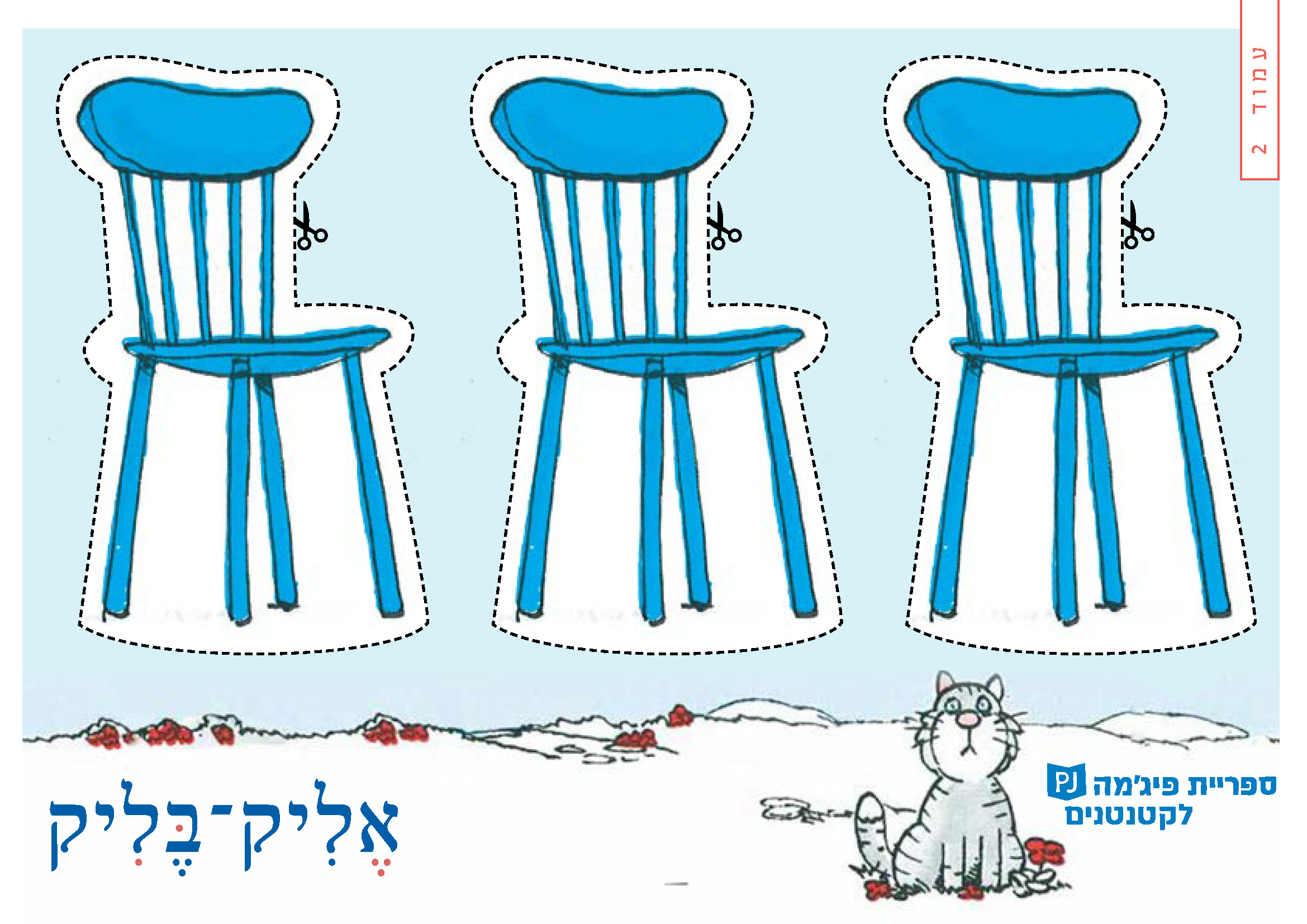
Reading Together
Do you also have little friends visiting your home? Are they imaginary friends, or maybe a beloved doll? It is worthwhile to talk about it with the toddlers and hear what do they like doing with the little friend. You can “bring in” the little friend to join and read the story.

How to Read the Story?
The story is slightly longer than usual, and in order to arouse interest and curiosity it is recommended telling it in a variety of voices: a voice for Dad, a voice for Yaeli and a different voice for Mom and for Elik Belik. You can look together at the illustrations and invite the toddlers to participate in the identification of details and repeat the words “Elik Belik”.

Hide and Seek
Where’s the doll? On the table? maybe underneath it? And where’s the ball? You can hide various objects, look for them and then say: “The ball is on the chair”, “The ball is under the bed”. You can also hide yourselves and look for each other.

From Small to Big
Dad has big shoes, Mom’s shoes – they are less big, Yaeli has little shoes, and Elik Belik’s? Tiny shoes! Go on a journey throughout the house, collect items of the same type and arrange them from the smallest to the biggest.
Reading, Singing and Moving
Let the toddler complete the repeating sentence: “Where to, where to? To kindergarten!”
You can add movements, clap hands or use musical instruments.
Our Morning Ritual
A fixed set of morning actions helps toddlers start the day well:
Prepare the clothes together, sing an encouraging song, collect leaves or a twig along the way, or say goodbye with a fixed, encouraging greeting.
Illustrations "Tell a Tale"
Look together and let the toddler find: Where is the bird? Is it on additional pages? Who accompanies the child to kindergarten? How do we get to kindergarten – by bicycle, walking or some other way? Who wears a hat and where is the dog?
Look at the last page and ask: “What are the children in kindergarten doing? What do you like to do at the nursery?”
Game: Where to?
Ask: Where to, where to? And each time choose a different place: To… The bath, the balcony, or to… The playground? Go together to the place you’ve chosen, hug each other and then say aloud: Where to, where to? To… the next place!
Reading poetry books
What do the gazelles do at night? And how does one go about reading a poetry book? Lea Goldberg’s book is filled to the brim with poems, and each of them is a small world unto itself. You could leaf through them, pick one by its illustration, prior acquaintance or personal preference, or even, an eye-catching title. You may enjoy reading it together, and then discussing it: Did you like the poem? What about it did you like? We recommend returning to favorite poems from time to time, and enjoying these works together.
Singing together
Some of the poems in this book have been put to music. You could find them on the various media channels and listen to their song rendition. You could also sing them together, play actual or makeshift musical instruments as you do, and accompany the song and music with a dance or simple suitable hand gestures. How about trying to sing one of your favorite poems to a much-loved tune?
Painting in three colors
The illustrations in this book were made by five different illustrators, whose names are listed on the final page of this book. You may want to leaf through the pages and look for the illustrations while attempting to guess what each illustration adds to or emphasizes in the poem. All the illustrations in this book have been colored green, white and pink. You could also try painting in two colors on a white sheet of paper, and create a shared drawing in two colors. How about mixing them together, creating squares and lines, and being inspired by the illustrations in the book?
A poem and a photo
A puddle? Light and shade? Perhaps a moon and bird? You may enjoy using a camera to take photographs inspired by the poems in this book. You can then print the photos out and add them to the book, or hold a family exhibition by sending photos and poems to your extended family.
Discussion
How many rooms does your house have? And what do you do in each one? You may want to look around and think: What do we really need, and what could we forego? You could discuss your own home, or imaginary ones. You parents could tell your children about the house in which you lived when you were their age: What are the differences and similarities between your childhood home and the current one?
Building houses
You can be builders too! You can build a house of Legos, cardboard boxes, pillows, or any other material. How about decorating the structure you’ve built, and asking your parents to help you write the name of the street it’s on. And who would you want to invite over to the house you’ve built?
An illustrated story
You may enjoy looking at the illustrations and discovering the other houses that appear in them: Who is building a house? And who is carrying one on their back?
One room
Look at the final illustration at the end of the book, where the main character is living in a single room: Which items does it contain? Would you have removed any of them, and brought in others in their stead? Which items found in your home would you have added to the room depicted in the illustration? You could take turns and have each family member pick an item in the illustration and decide whether or not they would leave it in the illustrated room, and if not, which item from your own home they would have placed there instead.
Illustrations tell a story
The illustrations in this book demonstrate how Itamar and the rabbit imagined one another versus what they really look like. You may want to check and compare: Do the monsters resemble the real child and rabbit? Are there any similarities between the monsters both Itamar and the rabbit had imagined?
Discussion
Were you, parents, also afraid when you were younger? Perhaps you could tell your children what you were afraid of, and how you grappled with your fear. You could also listen to your children as they tell you what scares them, and together, think of ways to overcome the fear.
Pleased to meet you: Monster
What does a scary monster look like? How about drawing one together, and then trying to imagine: What is the monster’s name? Who are its friends? What does it enjoy doing, and what is it afraid of? Now that you’ve gotten to know the monster, it may be worth asking yourselves whether it is still as scary as it was before.
A family magic word
“Jimalaya Jim! Zuzu buzu Yam Pam Puzu!” Each of the characters in this book has a magic word it uses when something scary happens. What is your magic word? You’re welcome to chose a family magic word together, and think of times when it would be appropriate to use it.
Dvora Omer
Authoress Dvora Omer (1932–2013) wrote dozens of books and stories for infants, children, and young adults. She began writing as a child, and continued as she grew older: “When I became a teacher, I began to write for children, and have published many books since then”. Omer wrote historical books for children that centered on prominent figures in the old Yishuv, as well as adventure stories, imaginative tales, folktales, jokes, and books about the challenges faced by both children and adolescents. Dvora Omer won many literature and children’s literature awards, and in 2006 was awarded the Israel Prize for her contribution to Israeli culture.
Discussion
During Chanukah, parents and children, families and friends, at home and in kindergarten, celebrate the Festival of Lights together. After candle lighting, you can talk about the way you celebrated Chanukah when you, parents, were younger, adding and sharing stories you heard told in your family, singing an old family song, or preparing your favorite food.
Mystery box
Would you like to have your very own mystery box? How about taking a cardboard box, decorating it, and hiding your favorite items in it? Let’s see who can guess which items you hid in it. And what did the rest of your family hide there?
Playing hide & seek
Following this story, you could play hide and seek, and search for one another. You could even hide a dreidel in various places around the house, using clues, arrows or other signs to help others discover its hiding-place.
We are all dreidels
With the candles lit beside us, and the smell of doughnuts in the air, you could pretend to be dreidels yourselves. You could be a “turtle dreidel” and spin slowly, an “airplane dreidel” – spinning and spreading your arms wide, or a “bear dreidel” that trudges heavily. And what else?
Reading together
שחקו במשחק בעקבות הספר “מי זה היה מה זה יהיה”!
🖨️ מדפיסים
✂️ גוזרים
🎲 ומשחקים!

Reading together
Where is the solution to this riddle? – This book was designed in such a way, that one page asks the riddle, and the next, provides the answer to it. You may want to ask your child to guess the answer before turning the page: completing the rhyme could help. No idea what it could be? Let your child turn the page and find out.

One last illustration
Look at the last illustration together. Illustrator Ora Ayal hid the answers to all the riddles in it. Are you able to find them? Can you recall a riddle associated with one of the details in this picture? You may enjoy trying to come up with a story containing as many of the answers to the riddles as you can.

Making up riddles
Choose an item, and use each round of the game to describe one of its characteristics. For instance: “It rolls”. Your child must discover which item you had in mind. Now switch.
You could ask your grandparents, friends, and relatives the riddles in this book. Perhaps they could even ask you some riddles, and see whether you were able to solve them.

A game of "what's missing?"
We have prepared some cards for you, which you can print out and use in this game of riddles, called “what’s missing?”
Lay out 3 or 4 cards. Now ask one of the players to close their eyes, and remove one card. When the player whose eyes were shut opens them again, you can ask them a riddle to remind them which is the missing card.
Note – the number of cards you play with should depend on the child’s ability.
Getting [into] the picture
Would you like to go into one of the illustrations in the book? You could choose to be a guest at the home of one of the families described in this story, and imagine how it would feel to be next to the whale, or in the kangaroo’s pouch. What would you want to happen when you meet some of the characters depicted in the illustrations?
Guessing the animals
One family member can make the sound of an animal, or draw a picture of it, imitate it, or give some other kind of clue about it – and the rest can try to guess which animal they were hinting at!
Sound – imitate the sound made by this animal
Pantomime – act the animal out, walk like it or try to look like it
Picture – show or draw a small part of the animal: a tail, wing or foot.
Clue – describe some detail about the animal: where it lives, what it looks like, or the sound it makes.
Couldn’t guess? Help each other by providing additional clues.

Songs and thoughts
The Sixteenth Sheep is an anthology of songs and stories that one can read one after the other, or select one at a time, according to the season, particular experience, or one’s mood. Could you write a song or story together about an everyday experience of yours? How about adding another verse to one of the songs found in the book?

That's happened to me too
While reading, you may want to discuss and examine the thoughts and feelings that emerge within both younger and older readers following the song. Does it remind you of experiences you have had? Parents, you may enjoy sharing your feelings and experiences nowadays and as children with your child.

When I grow up, I'm going to be a singer
Many of the poems in the book have become songs, and this may be a wonderful opportunity to listen to them, sing them together, and enjoy the tunes composed by Yoni Rechter and other musicians. You could record yourselves singing together, play along as you sing, or add a dance routine to your favorite songs.
When I grow up, I'm going to be a painter
Inspired by your favorite songs, you could be artistic in many ways: you could paint the green man using several shades of green, draw yourselves from the back, take a photo of a kindergarten when it is closed, or create the sixteenth sheep using cotton wool. When you have finished, you can show your work and ask: which song or story has inspired me to do this?

When I grow up, I'm going to be a painter
Inspired by your favorite songs, you could be artistic in many ways: you could paint the green man using several shades of green, draw yourselves from the back, take a photo of a kindergarten when it is closed, or create the sixteenth sheep using cotton wool. When you have finished, you can show your work and ask: which song or story has inspired me to do this?
Discussing – What can we see out of our window?
What can you see out of your window? What can you only see in your home? Can you see it through the window? What else makes you special as a family? Do you have a favorite song, or an activity you like to do together? Is there a fixed ritual on special occasions in your family, or something that will always make you all laugh? Perhaps there is a phrase or word that you have invented, or a word with a special meaning, that only your own family members understand? What is missing from your family that you wish to add? Something that would be seen through your window – a character, object, or animal? Perhaps something on which you could play a song?
Playing – it's me!
Who is this child? And who is this adult? – You may want to play a family game for boys, girls, adults, and children:
In each game round, a member of your family will think of one of the participants, and describe them indirectly. For instance: “The child I have in mind likes to play ball”, or: “The person I have in mind likes to drink coffee in the afternoon”. After the participant is described, everyone has to guess who the child or adult the player is thinking of is. You could also add friends and relatives with which all participants are familiar that are not physically present.
Ayin Hillel (1926–1990)
Ayin Hill (Hillel Omer) was born in Kibbutz Mishmar HaEmek in 1926. An author, poet, and landscape architect, Ayin Hillel often incorporated nature, landscapes, and animals into his poems. Many generations of Israeli children were raised on his literary gems, such as the Uncle Simcha stories, Why does the Zebra Wear Pajamas?, Yossi, Smart Child of Mine, and many others. Ayin Hillel also wrote poetry and prose for adults. He won many awards for his work, and passed away in 1990.
Proposed Family Activities:
- Rabbit’s tail appears in every illustration, but Rabbit cannot find it. You may want to ask your child to leaf through the book, and locate the tail on each page.
- You could attach a kerchief to the back of your child’s pants, and go searching for their tail around the house: Where is that tail hiding? Perhaps you could follow the route described in the book: under the bed, inside the shoes, under the pillow, in the kitchen, then the bathroom, and finally sit down. Like the rabbit in the story, your child can leap for joy when their lost tail is finally found.
- Can your child name their body parts? You may enjoy playing a game in which you ask your child: Where’s your elbow? Where’s your knee? Where’s your big toe? And have them point to each body part in turn.
- Rabbit looks in the bathroom and catches his reflection in the mirror. You may also want to stand in front of the mirror with your child, name one of the emotions felt by Rabbit throughout the book, and make the corresponding facial expression: smile to show joy, make a concerned face, get excited, and so on.
- Who has a tail? Perhaps you could take out some stuffed animals or look through a picture-book to discover what other animal has a tail. Which has long ears? What other animal can leap and jump?
delicious carrot cake
- What does Rabbit like to eat? Carrots, of course! How about making a delicious carrot cake together?
Ingredients:
2 eggs
½ a cup of sugar
1/3 cup of oil
2 medium-sized carrots, grated
1 cup self-raising flour (or 1 cup of white flour mixed with a teaspoon of baking powder)
½ a teaspoon of baking soda
1 flat teaspoon of cinnamon
Method:
- Preheat the oven to 180 degrees
- Mix all the ingredients in the order in which they appear
- Put the batter in an oiled baking pan, and bake for 20-25 minutes. Insert a toothpick into the cake, and when it comes out dry, the cake is ready
- Sit in the kitchen, eat the cake together, hug each other, and enjoy
Datia Ben Dor
Born in Alexandria, Egypt in 1944, and immigrated to Israel when she was a year old. During her early professional career, Ben Dor engaged in musical education, writing screenplays and songs for many TV shows for preschoolers, such as Parpar Nechmad (Lovely Butterfly) and the Israeli version of Sesame Street. Many of her children’s songs and books are very well-known and loved, among them: Ani Tamid Nishar Ani (Me is Me), Digdugim (Tickles), Otiyot Mefatpetot (Chatty Alphabet), and Kacha Zeh BeIvrit (That’s How Hebrew Is). Datia Ben Dor won awards for her contribution to children’s literature, such as the ACUM Award and Bialik Prize for Lifetime Achievement in Children’s Literature.
Proposed Family Activities:
- The child in this book asks the tree what it is like to be a tree. It may be interesting to discover your own child’s answer to the question: What is it like to be a child? What makes you special, and what makes you happy?
- Itay Bekin, the illustrator, added details that are not explicitly mentioned in the text of the story. Can your child identify all that is found underground, by the tree’s roots? Who makes frequent appearances in the illustrations, flying around throughout the book?
- The tree is happy to be rooted to a single spot, hear the birds chirping, and feel the dew falling. Perhaps you would enjoy playing “kind eye” with your child – look out the window together, look for good things, and share them with each other. You can then look inside the house, and continue playing by taking turns to tell each other what is good about your home and family, and what it is you like about them.
- You could go tree-spotting near your home. Try to notice which trees are growing in your area: Are they decorative or fruit-bearing? How can you tell whether they are young or old? Perhaps you could pack this book, a blanket and some refreshments, and read the story together in nature, under your favorite tree.
- Trees are very useful to us. You may enjoy walking through your home and looking for everything that is made from trees (wood) or their fruit. For instance: some of your furniture may be made of various kinds of wood; paper is made of wood shavings, as are books; olive oil is used for cooking and candle-lighting; wine and raisins come from grapes that grow on vines, and so on.
- Datia Ben Dor has written many well-loved stories and poems. You may want to look for them at home or the local library, and read them together.
Proposed Family Activities:
- You may want to look at the table of contents, choose a different idiom each time, and read the story that demonstrates it. Perhaps you could pick your favorite one, tell your child when you use it, and why you are so fond of it. If there is an idiom that your child particularly likes, ask them to tell you when they use it, and why they are so fond of it.
- The illustrations in this book are amusing, as they are a mixture of realistic and imaginary elements. You too could collect your favorite proverbs, illustrate them, and create your own family book of proverbs and idioms.
- How about playing a form of charades? You could each pick an idiom, and act it out. Were others able to guess which one you chose?
- Was your child familiar with the proverbs and idioms in the book before reading it? Do you and your child know any other expressions? Perhaps there are unique ones, whether in Hebrew or other languages, that are used by your family members? You could visit your grandparents, or uncles and aunts, and ask them to teach you a new proverb.
- You may enjoy making up your own idiom. Were you able to come up with one? If so, please send it to us, at pjisrael@hgf.org.il
“All good things come to an end” – this book celebrates the completion of five years of friendship between your family and PJ Library. We hope you have enjoyed reading the books you had received together, and wish your children many more years of joy reading books!
Leah Goldberg
Leah Goldberg (1911–1970), born in Kaunas, Lithuania, was a poetess, authoress, translator, professor, and editor, while also heading the Comparative Literature Department at the Hebrew University of Jerusalem. At the age of 23 she had completed her PhD on Semitic Linguistics in Germany, and upon immigrating to Israel in 1935, began to publish her writings, and soon became a well-loved and well-known poetess. Her publications, and among them her children’s stories and poems (Apartment to Rent [Dira Lehaskir], Magic Hat [Kova Ksamim], What do the Does do? [Ma Osot HaAyalot?], and many more) have become invaluable gems of Israeli literature. In 1970 she was awarded the Israel Prize for Literature; however, having unfortunately passed away several months prior to the ceremony, her mother received it on her behalf.
Enjoy reading and discussing the book together!
Family Activities:
- You may want to huddle together, leaf through the book, and ask your child to look for what each character received in exchange for the nuts. Pay attention to the facial expression of those receiving the nuts. Perhaps you could look in the mirror, and see what you look like when you smile with joy.
- How about looking for puppets or toys who could represent the dwarf, squirrel, lumberjacks, prince, princess, and child, and give a puppet theater rendition of the story together?
- Were you surprised by the ending? Perhaps you would like to make up your own, and illustrate it.
- The characters in this book sing when they are happy. What do you like to do when you are happy?
- Do you know any other stories or poems by Leah Goldberg? You could go over to the bookshelf at home or the local library, and look for some, such as The Scatterbrained Man from Azar’s Village (Hamefuzar miKafar Azar), Apartment to Rent (Dira Lehaskir), or The Bad Boy (HaYeled HaRa).
- The nuts in this book are magical: “whomever discovers their secret will be the happiest in the world”. You may want to share with one another what makes each of you happy. Are the same things that make you happy make your child happy too? Perhaps you can think of a family member or friend who you can surprise with something that will make them happy. How about making them some home-baked nut cookies?
Golden nut cookie recipe
Ingredients:
1.5 cups of flour
0.5 a cup of chopped nuts
150g of butter
100g of powdered sugar
1 teaspoon of vanilla extract
0.5 a teaspoon of powdered coffee
Method:
- Pre-heat your oven to 180 degrees
- Mix all the ingredients into dough and cool for an hour
- Roll the dough into nut-sized balls
- Place them on a lined baking pan and bake for 10 minutes
- Cool and store in a sealed jar
"Who's there, in the bag?"
You may enjoy giving each character in the story a different voice, and amusing yourselves with the words and rhymes. After you have read the story several times, your child could recognize the various fruit using the illustrations, and answer the rhyming question Dfik Dfok Dfik! Mi Sham Basakik? (“Knock, rap, bang! Who there, in the bag?”)
Going to market
Has your child ever tasted a carob or fig? Do they like oranges and bananas? You may like to take them with you to the market or supermarket, let them choose the fruit they like, and put them into your basket or bag. Together, you could make a fruit salad when you return home.
Six in a Bag, the Musical!
You may want to draw and color the fruit featured in this story, stick your drawings on popsicle sticks, and act the story out together.
Comparing apples and oranges – the tasting test
How do we recognize fruit? By their color, smell, or flavor? You may enjoy playing this guessing game: ask your child to close their eyes, and give them a piece of fruit to smell. Can they guess what it is? Let them taste it with their eyes closed. Do they recognize the flavor?
The bag in the story flies off with the wind
The bag in the story flies off with the wind. Has your child ever seen a bag tossed in the street? You could put it in the garbage can together, and help the environment. This may be a good opportunity to remind your child never to play with plastic bags!
Levin Kipnis (1894–1990)
Levin Kipnis wrote and translated hundreds of literary pieces for children, having set up and managed the first children’s theater in Israel. He also edited numerous journals, anthologies and textbooks.
For lack of holiday songs and stories in Hebrew suitable for young children, Kipnis proceeded to compile kindergarten curricula, and author much-loved children’s stories and poems on Jewish holidays, such as Svivon Sov Sov Sov (“Spin Spin Spin, Dreidel”) for Hanukkah, Ani Purim (“I am Purim”) for Purim, and Saleinu Al Ktefeinu (“Our Baskets are upon our Shoulders”) for Shavuot. His literary pieces contain messages of helping and consideration of others, such as in the famous Eliezer Vehagezer (“Eliezer and the Carrot”), Hamitriya Hagdola shel Abba (“Daddy’s Big Umbrella”), and Shloshet Haparparim (“The Three Butterflies”).
Levin Kipnis was a particularly prolific author, and won many awards, including the Israel Prize and Hans Christian Andersen Award.
Reading differently:
Reading differently: Reading poetry and prose are different experiences. The nursery rhymes in this book are short and catchy, and are accompanied by Shulamit Tzarfati’s joyful and colorful illustrations. You may want to ask your child to leaf through the book, picking a different rhyme each time. As you re-read the book, your child will become familiar with the words, and recite them on their own.
Singing together
Singing together: Some of the nursery rhymes in this book have been put to music. If you do not know the tunes, you could look them up on the internet, listen to them, and sing along with your child. You could also accompany your singing with simple musical instruments: a tambourine, bell, harmonica, or even two wooden spoons.
Putting on a show
Putting on a show: You may want to suggest that your child use some toys and stuffed animals to act their favorite rhymes out. You may also enjoy adding some choreography: riding a broomstick while singing “Parash” [Horseman]; setting up a pots & pans band and dancing around to “Makhelat Nognim” [The Band]; or flying like butterflies in the footsteps of “Haperach Laparpar” [The Flower to the Butterfly].
For the chain continues yet
For the chain continues yet: Do you remember any songs you learned as children? After reading this book, perhaps you could try to remember songs you once knew off by heart, sing them, and introduce them to your children too.
Hayim Nahman Bialik
Hayim Nahman Bialik (1873–1934) – Israel’s national poet
Hayim Nahman Bialik, one of Hebrew Literature’s greatest contributors in the Modern Era, has greatly impacted Modern Jewish culture. Bialik wrote stories and poems for both children and adults, many of his publications were translated into various languages, and a fair share of his poems put to music. His lifelong achievement was building a bridge between the Hebrew preserved in Jewish literature for thousands of years, and the language reborn at the turn of the 20th century in Eretz Israel.
האזינו לסיפור "העופר המסכן" מהספר "סיפורי חיות"
הקשיבו, הקשיבו!!! 🎧 ילדות וילדים, הורים וצוותים חינוכיים ❤️ הימים האלו עכשיו הם ימים לא רגילים, ובימים כאלה סיפורים יכולים לשמח, לרגש, אפילו להצחיק. אנו מזמינים אתכם/ן להאזין להקלטה הקסומה של הסיפור “העופר המסכן”, מתוך “סיפורי חיות”, מאת: עודד בורלא | איורים: אסיה אייזנשטיין | הוצאת: ידיעות ספרים.
יוצרים ומגישים – ירדן בר כוכבא – הלפרין ודידי שחר מוזיקה ונגינה – טל בלכרוביץ’ פתיח ההסכת ולחן השיר בסיפור “החוצה” – דידי שחר.
מוכנים/ות? מת – חי – לים! ▶️
האזינו לסיפור "ההמצאות של קרפד"
הקשיבו, הקשיבו!!! 🎧 ילדות וילדים, הורים וצוותים חינוכיים ❤️ הימים האלו עכשיו הם ימים לא רגילים, ובימים כאלה סיפורים יכולים לשמח, לרגש, אפילו להצחיק. אנו מזמינים אתכם/ן להאזין להקלטה הקסומה של הסיפור “ההמצאות של קרפד” מתוך הספר “סיפורי חיות” מאת: עודד בורלא, איורים: אסיה אייזנשטיין.
יוצרים ומגישים: ירדן בר כוכבא – הלפרין ודידי שחר
מוזיקה ונגינה: טל בלכרוביץ’
פתיח: דידי שחר

Oded Burla (1915–2009)
Author, poet and painter Oded Burla was born in Jerusalem Sephardi family that had lived in this country for over thirteen generations. He published his first book at the age of 45, and went on to write and illustrate more than 70 children’s books, in which, he once claimed, 346 different animals were mentioned! Burla is considered the founding father of nonsense in Hebrew children’s literature; his books are filled with sophisticated humor and a use of language that is both surprising and amusing. For his work, Oded Burla has been awarded the Zeev Prize, ACUM Award, and Bialik Prize.

Proposed Family Activities:
- Animal stories have morals from which people can learn. You may enjoy reading the stories together, and trying to discover the subtle messages conveyed by them. What makes someone pitiful? Why did the tiger help the warbler? Is kindness contagious? And what can a squirrel teach us about independence?
- What about the stories did your child find amusing? The animals and their behavior? The surprising endings the author chose for his stories? Or perhaps the illustrations?
- The toad is an inventor with a great imagination. But are all his inventions necessary or useful? Perhaps you could also let your imaginations run wild, and invent new things together. Are your inventions useful?
- In the poem entitled “Noah’s chick” (HaEfroah shel Noach), almost every line rhymes with “Noah”. You may also choose a word or sound, and try to write a poem in which every line rhymes with that sound. How long was your poem?
- The story about Sakiki the Saki contains a plethora of idioms and phrases containing the Hebrew word for “eye” – ayin. You may want to make an amusing, illustrated dictionary together containing all the expressions found in this story in picture form.
- Do you also like animals and stories? Then how about going to the zoo with a notebook and pen, and drawing all the animals that remind you of certain people? Together, you can make up stories with morals about them, and write them down, to create your very own animal stories.
Proposed Family Activities:
- You may want to sit close together, read the story, and look at the illustrations. Perhaps you could look for indications of the differences between Leah and Rivka’s life stories. After reading the story for the first time, you may enjoy reading or telling the story together, each of you playing a different role: one of you can be in charge of telling Leah’s life story, the other – Rivka’s.
- Leah and Rivka were fluent in many languages, among them music and drawing! Perhaps you could pick one word, an emotion or object, and think of different ways and languages in which to express them – in words, movement, art etc.
- How much does your child know about your own childhood? You may want to set up a time for “getting to know one another session”. You could encourage your child to ask you questions, or prepare a scrapbook together of landmarks in yours and your child’s lives – at home, with the family, in the neighborhood with friends.
- At the basis of Leah and Rivka’s friendship is their love of music and art. Do you also like to sing? Do you happen to play a musical instrument? You may enjoy making a songbook filled with all your favorite songs, and invite your friends and family to a night of song and dance.
- When Leah and Rivka were unable to meet in person, they wrote letters to one another. Perhaps you could suggest that your child pick a friend or family member with whom to correspond. The letters should be handwritten and drawn, and just like old times – put them into envelopes, stick a stamp on, put them in the mailbox, and feel your excitement mount as you wait for a response.
- Do you know any other works by Leah Goldberg? You may want to look for more of her stories at home or the local library: The Absent-Minded Guy from Kfar Azar (Hamefuzar Mikfar Azar), Fibber the Storyteller (Mar Guzmay HaBaday), Wonders and Miracles (Nissim VeNiflaot), or her poetry book, What Do the Does Do? (Ma Osot HaAyalot?)
Elisheva's friends come to her aid
Elisheva’s friends come to her aid – they travel, endanger themselves, and are even willing to make an effort and take risks to help her get well. Perhaps you would enjoy remembering a time of need when you were helped by a family member or friend, or else share a memory of a time when you helped a fried in need.
Following the story, you may want to discuss
Following the story, you may want to discuss reality and make-believe, friendship and compassion, breaking and fixing.
Do you have any dolls or toys that need fixing
Do you have any dolls or toys that need fixing? You could look for “injured” games together, and try to fix them.
This book was first published in 1944, and the language used in it is in keeping with the times.
This book was first published in 1944, and the language used in it is in keeping with the times. Did you come across any words or phrases with which your child was not familiar? You may want to ask them who is telling the story, in their opinion – who is the feminine voice that expresses an opinion every once in a while – and what they think of this character.
You may enjoy leafing through the book and looking at the beautiful illustrations
You may enjoy leafing through the book and looking at the beautiful illustrations by illustrator Batia Kolton. You could pick your favorite excerpt of the story, and draw it.
Miriam Yalan Shtekelis wrote many other poems and stories
Miriam Yalan Shtekelis wrote many other poems and stories: Flower for Nurit, The Running Dwarves, Brave Little Danny, and more. You may want to look for them at home or the library.
This is the last PJ Library book you will be receiving. We hope you have enjoyed the books throughout your time at kindergarten and school, and may you read a whole lot more!
Miriam Yalan Shtekelis
Miriam Yalan Shtekelis (1900–1984)
Poet and author Miriam Yalan Shtekelis was born in the Ukraine in 1900. Her father, Dr. Yehuda Leib Wilensky, was a Zionist leader (her last name, Yalan, consists of his initials). Miriam was given a Jewish Zionist education, and immigrated to Israel at the age of 20. She settled in Jerusalem and worked at the Jewish National and University Library (JNUL) for many years. She wrote and translated dozens of children’s poems and stories, and some of her poetry was put to music. Among her well-loved songs are Flower for Nurit, The Soap Cried, Zehava the Doll, and The Rabbit has made a Home. Miriam Yalan Shtekelis was greatly appreciated in life for her writing for children, and was an Israel Prize laureate for children’s literature.
reading the rhyming tale several times
You may enjoy reading the rhyming tale several times, and asking your child to join in for the refrain:
“הִנֵּה כָּךְ הוּא הַמְפֻזָּר, הַמְפֻזָּר מִכְּפַר אֲזַ”ר!”
You could also learn to recite some of the poem off by heart, letting the illustrations remind you of the words.
Were you told the story of the scatterbrained man
Were you told the story of the scatterbrained man (or a similar tale, whether by Samuil Marshak or another author) when you were growing up? Do you have another version of the story at home? You may enjoy reminiscing together, sharing memories with your child, and comparing both illustrations and stories.
What do you find funny?
What do you find funny? Perhaps you would like to look for all the things the scatterbrained man does wrong in the illustrations, and act some of them out.
You may enjoy coming up with an additional part of the story, and acting it out
You may enjoy coming up with an additional part of the story, and acting it out. What do you think happened to the scatterbrained man from Azar’s Village as he continued to sit in the stationary railroad car on his way to Jerusalem?
We all behave like scatterbrains sometimes!
We all behave like scatterbrains sometimes! You may want to share memories of silly things you had done when your mind had wandered, or occasions on which you were particularly confused, and make each other laugh.
Do you know any other book by Lea Goldberg?
Do you know any other book by Lea Goldberg? You may want to look for and read more of her stories and poems together, such as Where is Pluto (Ayeh Pluto?), Apartment to Rent (Dira Lehaskir), and the collection of poems entitled What do the Does do? (Ma Osot HaAyalot?
Lea Goldberg
Lea Goldberg (1911–1970), born in Kaunas, Lithuania, was a poetess, authoress, translator, professor, and editor, while also heading the Comparative Literature Department at the Hebrew University of Jerusalem. At the age of 23 she had completed her PhD on Semitic Linguistics in Germany, and upon immigrating to Israel in 1935, began to publish her writings, and soon became a well-loved and well-known poetess. Her publications, and among them her children’s stories and poems (Apartment to Rent [Dira Lehaskir], Magic Hat [Kova Ksamim], What do the Does do? [Ma Osot HaAyalot?], and many more) have become invaluable gems of Israeli literature. In 1970 she was awarded the Israel Prize for Literature; however, having unfortunately passed away two months prior to the ceremony, her mother received it on her behalf.
look at the illustrations together
Perhaps you would like to look at the illustrations together, and search for differences between then and now. What did the iron look like in the past? Were trains and buses similar to the ones we have now? And what is the bus driver holding? You could try looking for the rooster throughout the book. What is it doing on each page?
Proposed Family Activities:
- Unlike stories, a collection of poetry can be read in any order. Which poems were your favorite? And your child’s? Feel free to read the book over and over again, asking your child to pick just one or two poems at a time, and returning to your favorites time after time. After a while, your child will know the poems, and join in on your reading, completing the rhyming lines.
- Each of the poems in the book can be acted out using items found in every home. You may want to select one of your favorite poems and act it out together. You could also put it to music, or a certain rhythm, using a musical instrument. You may also enjoy putting together a small dance to go with your favorite poem.
- You may like to ask your child to place their head on your lap and close their eyes. As you read, ask your child to imagine the poem, and try to think how they might have illustrated it. When your child opens their eyes again, show them Inbal Leitner’s illustration, and ask them whether they had imagined the poem as Inbal had. Perhaps you would then like to draw the illustration as you imagined it would be.
- If you look at the illustrations, you will notice the embroidery by Elina Zashkevich-Chipiga. Perhaps you could also take out colorful thread, and embroider your child’s name onto their backpack, or decorate a pillow cover.
- Shlomit Cohen Asif’s poems provides us with insight into a child’s inner world, as well as a wonderful opportunity to hold an open discussion on feelings. In the poem Fear sat on the blue chair, even Fear is scared of being alone. You may want to share your fears with one another, and try to find ways to overcome them together.
- White sheet, what will you become? Let your imagination run wild with a white sheet of paper. You could write, paint, or doodle on it, roll it into a ball, make a tiara out of it, or perhaps a kite, or pirate ship, being creative and drawing inspiration from the poems in the book.
- Shlomit Cohen Asif has written over 70 books. Do you know any other work by her? You may want to look for more stories and poems by her at home, in your kindergarten library, or the public one, and enjoy reading them together.
Enjoy reading and discussing the book together!
Shlomit Cohen Asif was born in Iraq in 1949, and immigrated to Israel with her family at the age of 18 months. She wrote dozens of children’s books containing tales, stories, and poems. Among her well-loved works are Mamushi the Rabbit, Three Nice Mice Birthdays, and When the Star fell into a Puddle. Shlomit Cohen Asif is a well-loved and respected writer, and many of her poems have been put to music, translated into foreign languages, and adapted to stage productions. Over the years Cohen Asif has won many awards for her work, among them the Ze’ev Prize for Children’s Literature, the Bialik Prize, and the ACUM Prize for Lifetime Achievement in Children’s Literature.
Where is the Heart?
You may want to look at the illustrations in the book together. What grows on each tree? Has your child noticed that the story begins with a small heart on Hannan’s pocket, and ends in five heart-shaped trees? Leaf through the pages and try to find the bird on each page.
A Bell and Song
You may enjoy reading the story several times. Your child may want to join in for the refrain: “דין דין דון בפעמון”. Once you have read the story through several times, your child may be familiar enough with the story to tell it using the illustrations.
The Five Sense Game
Perhaps you would like to play a fruit guessing game together. Cover your child’s eyes with a kerchief, and hand them some fruit. Can they recognize it? You may want to guide them to use their sense of touch and smell. They can also bite the fruit, and try to identify it through their sense of taste.
One Book Leads to Another
Do you know any other books written and illustrated by Rinat Hoffer (such as Ayelet Metayelet and Purple Monster)? You may want to look for them at home or the library, and read them together.
The Trees around Us
Perhaps you would like to take a walk together, and look for trees growing in the area: are they bearing fruit like the trees planted by Hannan the Gardener?
A Surprise in the Avocado
Would you also like to grow a treasure? You may want to take an avocado pit, stich four toothpicks through it and place it in a jar, with the sharp point pointing upwards, and the wider section dipped in water. You could follow it as it sprouts: is your avocado pit growing into a tree?
Where's the Treasure?
You may enjoy going on a treasure hunt. You could prepare notes with clues, and lead your child closer to the hidden treasure with each note.
Fruit Salad
How about making fruit salad? You may want to take a tangerine, orange, apples, dates, and other fruit, and make a healthy, yummy fruit salad together.
Family Activities
- Notice the special illustrations in the book. Mommy and Yossi have various “accompaniers”. Which accompany Yossi each time he goes out? Which items “accompany” Mommy when is waiting at home? In your opinion, do you think there is any significance to the various “accompaniers”?
- Collage artist Liat Yaniv added to the song-story through rich illustrations, using the craft of pasting small pieces of colored paper. Young children, too, can prepare a picture by pasting pieces of paper. You can either tear or cut pieces from newspapers and journals and prepare from them a colorful
- Yossi found a harmonica and played for Mommy. You can prepare a harmonica from a comb and specially waxed paper for baking (in Hebrew, “pergament” paper): Cut the baking
paper to a width that is double the space of the comb, wrap the comb with it and blow. You may even want to create a “comb orchestra”.
- In what area or way is your child successful? It would be nice to create a medal on which is written “My Successful Son” or “My Successful Daughter”. Write or draw onto it something that the child has done successfully. You may also want to prepare a “Reward Note” about the successful things that the child did during the week, and to read it during Friday night
- “Educate a child in the way he should go”: You can discover a lot about your children if you follow after their “special steps”. You may want to join them as they engage in all kinds of entertaining and amusing activities, each following along “in the way” that he “goes”. For example, rules for various games, a dance that they invented and silly and funny songs that they made
- Are you familiar with the melody of the well-known song “Yossi, My Wonderful Child”? This is a fine opportunity not only for reading the story together, but also for singing it!
Family Activities
- In our story there are things that don’t fit into place, things that are ridiculous and the opposite of what one expects. You can thumb through the pages together, examining the illustrations and discovering these things.
- The children can draw pictures of the grandfather, grandson and the donkey and paste them onto the backs of small magnets. The three characters are invited to set out on a “journey” on the refrigerator door or any oother metal surface. They can take turns, sometimes galloping and sometimes being carried.
- Instead of riding on the donkey, the grandfather and the grandson carry the donkey on their shoulders! Select an object, and use it in a different way than for what it was originally intended. Place a number of household objects with which the children are familiar in a box. Each participant takes out an object and uses it in a way that is different from its intended use.
- Who can keep a straight face? Each person in turn tells the next one: “My donkey, hee-haw,” and tries to get him to laugh. Continue saying this back and forth, faster and faster, until one of you bursts out laughing.
- Grandmother waits at home for Grandfather and the grandson. When they return, she is sure to ask them, “How was your journey?” You and your child can be the grandson and grandfather, and explain in your own words what happened on the way to the city.
- Share funny stories with your child. Think back to funny events that happened to you and share stories from the family lore. Be sure to explain the difference between “laughing at someone” and “laughing with someone”!
Sofma’asehbimachshavatechila (Think before you act)
“Sofma’asehbimachshavatechila” or, “Think before you act,” is an expression taken from the Shabbat hymn “LechaDodi” that Rabbi ShlomoAlkabetz wrote in France about 400 years ago. The hymn tells of G-d’s creating the world in six days with the thought that the Sabbath will arrive at the end of the week and will be the height of the creation.
A person who knows where he wants to go will have an easier time getting there. Is it possible to adopt every suggestion we are offered? How do we know which suggestion is the right one for us?
- When a donkey knows the path he will not stray from it. This is how he brings his rider to his destination in the safest way. Together you’re your child, look at the expression on the donkey’s face throughout the story. What, in your opinion, does he feel on hearing all the advice he receives?
- Each person who passes by gives the grandfather and the grandson advice, and the two become very confused. At the end of the day Grandfather says, “We can’t please everyone.” You can discuss with your child: Who knows us well? Whose advice should we accept? Whose opinion should influence us the least? When should we stand up for our rights and not be drawn into something we know is wrong, on the advice of others?
- Sometimes we feel that what others say is more important than our own inner sense of right and wrong. This is a good opportunity to help your children develop their self-esteem and trust their instincts. The absurd ending of the story illustrates with humor the price of going along with others without giving thought to one’s own beliefs.
- From start to finish: Using toy figurines, you can plan the route of Grandfather, grandson and the donkey with your child. Place pieces of Lego, blocks, or even pillows throughout the room. Before setting out, consider the route together, from the planning stage until the completion of the journey, and move the characters along the way from the stable to the city gate and back home again.

Family reading advice – “And what else”?
Some books leave a question open ended, or a sentence requiring completion at the end of each page, so as to provide young readers with the opportunity to become curious, participate and guess what will await them on the next page. While reading, you should pause between pages, speculating or imagining together what the next page holds.

Discussion – Just like every Friday
Following this story, you can think together – What is it that you do every Friday? Do you also have fixed preparations, errands or family rituals? What is your favorite thing to do on a Friday? Have you ever felt that Shabbat was more festive and enjoyable because you worked especially hard toward or looked forward to it?

Datia Ben Dor reads the story
Enjoy listening to the book’s author, Datia Ben Dor, read the story aloud.
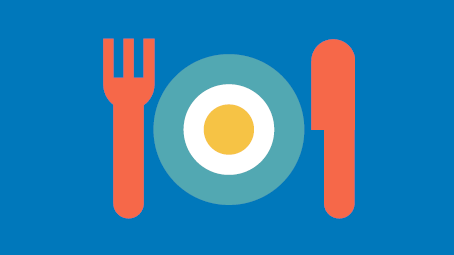
Recipes for Shabbat
Tomato juice? Orange jelly? How about a fried latke? You can leaf through the book, choose any of the dishes and beverages appearing in the story, and prepare it together. Once they are ready, you can check – How many potatoes did you use to make the latkes? And how many oranges did you use to make the jelly?

Playing with the illustrations
Avner Katz’s classic illustrations depict Yo-Yo’s many errands: carrying a large watermelon; riding his bike; and taking a bath. You can play charades – take turns opening the book on a random page, and pantomiming the illustration while your family tries to guess what Yo-Yo is doing now.

Memory game
Have you read this book over and over again? Now’s the time to see what you remember! Children enjoy re-reading the same book – they feel confident and satisfied when they remember it and can tell it to themselves. Suggest that the children complete from memory – How many tomatoes? How many brushes? Ask them to test your memory too, asking you about specific details from the story.
האם הילדים מכירים קומיקס?
האם הילדים מכירים קומיקס? סיפור קומיקס, או “עלילון”, הוא בעצם סיפור כפול: הרפתקאותיו של אורי כדורי כפי שמתוארות במילים, ועלילת הציורים. לא צריך לדעת לקרוא כדי לפענח טורי קומיקס! ילדי הגן יוכלו “לקרוא” את הציורים ולספר את הסיפור במילים שלהם.
להסב את תשומת לב הילדים לכלב הגדול שלמלווה את אורי ברוב הרפתקאותיו
כדאי להסב את תשומת לב הילדים לכלב הגדול שלמלווה את אורי ברוב הרפתקאותיו. הכלב לא מוזכר בסיפורים, והוא פרי דמיונה של המאיירת רותו מודן. אפשר לשוחח עם הילדים, מה עושה הכלב בסיפורים?
לצייר טור קומיקס
ילדי הגן יכולים גם לצייר טור קומיקס. ניתן לבקש מהם לבחור סיפור מוכּר ולהכין ממנו קומיקס.
משחק: כל אחד בוחר חפץ בחדר ועושה בו שימוש מצחיק ובלתי-שגרתי
אחד הדברים המצחיקים ב”אורי כדורי” הוא השימוש הבלתי-שגרתי בחפצים מוכּרים. אפשר לשחק משחק: כל אחד בוחר חפץ בחדר ועושה בו שימוש מצחיק ובלתי-שגרתי. על השני לנחש לְמה הפך החפץ המוכּר.
לשאול את הילדים מה הם ממציאים ולבקש שיתבוננו בתמונות ויגלו מה החליט אורי לעשות.
אורי כדורי ממציא פתרונות מגוחכים לבעיות שונות (כיצד להתייבש לאחר הגשם, מה לעשות בקליפת בננה כשאין בסביבה פח, איך להתאים את גובהו של כסא לשולחן…). אפשר לקרוא את סיפורונים יחד ולעצור לפני הפתרון, לשאול את הילדים מה הם ממציאים ולבקש שיתבוננו בתמונות ויגלו מה החליט אורי לעשות.
לשוחח בקבוצות קטנות
האם עלילותיו של אורי כדורי הצחיקו את הילדים? איזה סיפור אהבו במיוחד? אפשר לשוחח בקבוצות קטנות, לבחון את הפרטים הקטנים שבאיורים ולאפשר לילדים להביע את העדפותיהם.
מפגש בדיחות וצחוק
בעקבות הקומיקס ולקראת חג פורים אפשר לערוך יחד עם ההורים “מפגש בדיחות וצחוק”, עם סדנאות לכתיבת קומיקס, שעשועים וחידות, ושירים היתוליים.
יצירות נוספות שכתבה לאה גולדברג
האם ילדי הגן מכירים יצירות נוספות שכתבה לאה גולדברג (למשל, “איה פלוטו?”, “דירה להשכיר”, “הילד הרע” ועוד)? אפשר להכיר לילדים את דמות היוצרת ולערוך תצוגה בגן. כדאי לבקש מהילדים לחפש בבית ספרים ושירים פרי עטה ולצרף אותם לתצוגה.
לספר את העלילה במילים
לא צריך לדעת לקרוא כדי לפענח טורי קומיקס! ילדיכם יוכלו “לקרוא” את הציורים ולספר את העלילה במילים שלהם.
להכין קומיקס
גם ילדים צעירים יכולים לצייר טור קומיקס. ניתן לבקש מילדיכם לבחור סיפור מוכּר ולהכין ממנו קומיקס.
לשחק משחק: כל אחד בוחר חפץ בחדר ועושה בו שימוש מצחיק ובלתי-שגרתי
אחד הדברים המצחיקים ב”אורי כדורי” הוא השימוש הבלתי-שגרתי בחפצים מוכּרים – למשל, כאשר אורי כדורי תולה את עצמו על חבל הכביסה, או מושיט חכה כדי לדוג דג זהב מתוך אקווריום. אפשר לשחק משחק: כל אחד בוחר חפץ בחדר ועושה בו שימוש מצחיק ובלתי-שגרתי. על השני לנחש לְמה הפך החפץ המוכּר.
לקרוא שוב את הקומיקס ולשאול את ילדיכם, מה הבעיה ומה הפתרון בכל סיפור?
כל אחת מעלילותיו של אורי כדורי עוסקת בפתרון מגוחך לבעיה שעומדת בפני הגיבור. אפשר לקרוא שוב את הקומיקס ולשאול את ילדיכם, מה הבעיה ומה הפתרון בכל סיפור? יחד תוכלו להמציא עוד פתרונות מצחיקים לבעיות.
מה מצחיק אתכם?
מה מצחיק אתכם? בעקבות הקומיקס ולקראת חג פורים אפשר לערוך “ערב בדיחות וצחוק” במשפחה.
יצירות נוספות שכתבה לאה גולדברג
האם אתם מכירים יצירות נוספות שכתבה לאה גולדברג? אפשר לחפש בבית, בספריית הגן או בספרייה המקומית ספרים ושירים פרי עטה וליהנות יחד גם מהם.
Activities You Can Do at Home
- “Take a walk” with your children through the pages of this book. Examine the illustrations closely and find what is being described in the song. The illustrator, Liat Yaniv, added details that do not appear in the text. See if you can find them!
- The illustrations are masterpieces of glued strips of colored paper. Even very young children can make a picture by gluing strips of paper. You can tear or cut pages from old magazines and make a colorful collage out of the strips.
- The song “A Short Walk” has a simple melody with a beat that is well suited to the pace of walking. If you know the tune, you might sing the song together. You could also find other songs by Naomi Shemer and put together a little Naomi Shemer Song-Book for a family singing night.
- The song’s lyrics reflect the landscape of Naomi Shemer’s childhood, which she spent on a kibbutz by the Sea of Galilee. What does your own neighborhood look like?
- Like the children in the song, you might go on a short walk close to home. Each member of your family could take turns saying what s/he sees: “I see an ant!” “I see a bird!” Do you all notice the same things?
- Going for a walk together offers a wonderful opportunity for conversation. You might ask your children what excites and what amazes them, and then share your own thoughts and feelings with them.
- After your walk is over, you might sketch the route from your house to the children’s kindergarten, and then add illustrations showing the plants and creatures that you met along the way.
Family Activities:
- If you carefully follow the text and illustrations of the story, you will surely note the different paths taken by the words and the pictures. Read the story again with your child. Each time you arrive at the sentence “Meanwhile, Hannah Banana rushed on her way…” ask your children to describe what they see in the picture. Is Hannah Banana really rushing? What does she do and whom does she meet along the way to Granny’s house?
- Did you notice the cat who accompanies Hannah Banana on her way to Granny’s house? You can ask your child to point out the cat on each page, and ask them how they think Granny will greet him when he arrives at her house.
- You can play the finger game “One Little Piggy” with your child. According to the story, who “had none” at the end of the rhyme?
- Hannah Banana’s Granny Cooked Porridge is actually two stories that happen at the same time. You can act out the stories with your child. First ask your child to be Hannah Banana on her way to grandmother’s house, while you pretend to be Granny. Then you can change roles. If other family members or friends are with you, they can be included in the skit as well and take on the roles of the neighbors.
- “To each his own”: At the end of the story we discover that Hannah Banana doesn’t even like porridge! You can ask your children if they believe this, and discuss which foods they like in particular and what they don’t really like.
- You can explain to your children that “Hannah Banana” is a nickname. Do your children have a nickname or a special name that only some people use when addressing them? If so, do they like their nickname?
Here is a simple recipe for delicious, sweet porridge:
Ingredients: 1 cup water, 2 cups milk, 3-4 tablespoons semolina, 3 tablespoons sugar, cinnamon, butter
Preparation: Cook the water, milk, semolina and sugar over a low flame, stirring constantly. Bring to a boil. The porridge is ready when the mixture is boiling and the semolina is cooked. Sprinkle with cinnamon and add a dab of butter. Bon Appetite!
מה אתם אוהבים בשבת?
מה אתם אוהבים בשבת? האם מבוגרים וילדים אוהבים את אותם הדברים? עבור ילדי הגן יום השבת הוא (גם) היום בו משתבש המסלול המוכר: הם אינם מבקרים בגן, לא נפגשים איתך ועם חבריהם, לא משתתפים במפגש בוקר ולא אוכלים יחד ארוחת עשר. יש ילדים שעבורם יום זה מהנה ביותר, אך עבור אחרים שמתקשים להתרגל לשינויים ומעברים, יום שבת עשוי להיות יום לא קל. כדאי לקחת זאת בחשבון בשיחות עם הילדים בעקבות השיר.
האיורים של מנחם הלברשטט מבליטים את הניגודים הרבים בין יום השבת לבין שגרת ימי חול
האיורים של מנחם הלברשטט מבליטים את הניגודים הרבים בין יום השבת לבין שגרת ימי חול. כדאי להזמין את הילדים לעיין באיורים ולהבחין בפרטים שמייצגים את הפעילות בכל יום בשבוע. בהמשך ניתן להציע להם לצייר שני ציורים זה לצד זה: אחד שמייצג את השבת, השני של יום חול.
"בשבת אבי ישן עם העיתון שלו, ואמי אומרת כן הרבה יותר מלא..."
“בשבת אבי ישן עם העיתון שלו, ואמי אומרת כן הרבה יותר מלא…”: שורות אלה בשיר יכולות לשמש פתיח לשיחה עם קבוצת ילדים על השבת במשפחות שלהם: מה עושה המשפחה שלהם בשבת? האם יש להם מנהגים מיוחדים, דברים שהם עושים רק בשבת? האם הם הולכים לבית הכנסת, מטיילים, נחים או מארחים? תוכלי לבקש מהורים וילדים לצייר יחד את מה שהם כמשפחה אוהבים בשבת, ולהציג את התמונות בלוח עם הכותרת “מי אוהב את השבת? אני, אתה ואת!”
הסתכלו היטב התמונה של שולחן השבת
הסתכלו היטב התמונה של שולחן השבת. בתמונה זו פרטים רבים ומגוונים, אפשר לעיין בה יחד עם הילדים ולהתייחס אליה כ”מדרש תמונה”. האם מצאתם רמז באחת הצלחות לסיפור אחר ידוע על השבת? לחצו כאן לקרוא את הסיפור!
לבקש מכל משפחה לצלם את שולחן השבת שלהם
בעקבות התמונה בספר שמתארת את שולחן השבת, תוכלי לבקש מכל משפחה לצלם את שולחן השבת שלהם. אפשר לערוך תערוכת צילומים של שולחנות שבת.
ספר מתכונים של מאכלי שבת
אפשר להכין ספר מתכונים של מאכלי שבת, בשיתוף משפחות הגן. כל משפחה תתרום מתכון למאכל אותו הם אוכלים בשבת, ותוסיף ציור של הילד או תיאור של חוויה משפחתית.
קבלת שבת משותפת
תוכלי להזמין את ההורים לסדנא בנושא השבת, או לקבלת שבת משותפת עם הילדים. אל תשכחו לשיר יחד את השיר “מי אוהב את השבת”!
שיר הוא גם הזדמנות לרקוד!
שיר הוא גם הזדמנות לרקוד! תוכלו לחפש את התמונה שבה עדנה הפרה רוקדת, ולהמציא תנועות וריקוד שילוו את השיר.
פנטומימה שבת
אפשר לשחק משחק קבוצתי – “פנטומימה שבת”: כל ילד בתורו ממחיז ללא מילים פעולה הקשורה לשבת (מנוחה, קידוש, קריאת ספר, שירה, משחק,…). יתר הקבוצה מנסה לנחש את הפעולה.
בשבת הציפורים שרות מרוב שמחה
“בשבת הציפורים שרות מרוב שמחה”. אפשר לשאול את הילדים, האם רק בשבת הציפורים שרות מרוב שמחה? מעניין יהיה לשמוע (ואף לרשום ולהראות להורים) את תשובות הילדים. אולי בשבת יש לנו השקט והפניות להבחין יותר בשירתן? ניתן גם לפתח שיחה בנושא “שירת הבריאה”- איך כל חי/ יצור מהטבע אומר שירה? הילדים יכולים לשייך מילים לקולות של בעלי חיים (החמור – נוער, התרנגול – קורא , החתול – מילל וכו’).
לבקש מהילדים לחפש בספר את התמונות של השעונים
תוכלי לבקש מהילדים לחפש בספר את התמונות של השעונים. האם באמת ימי החול ארוכים יותר מיום שבת? איך מסבירים את המשפט בשיר “יום ראשון שני שלישי, כל יום נמשך שנה”? יש האומרים : “כשנהנים- הזמן עובר מהר”…
ציון יום שישי כיום מיוחד במינו בגן שלהן
מגוון רעיונות שונים של גננות, לציון יום שישי כיום מיוחד במינו בגן שלהן:
ארגון שונה של הסביבה הפיזית של הגן
אפיית חלות או עוגה
ארוחת עשר מיוחדת וחגיגית
משחקים שונים, בהם משחקים רק ביום שישי
כלי שולחן מיוחדים ותחפושות שמעודדים שילוב “ארוחת שבת” בפינת הבית
“בגדי שבת” לבובות בפינה למשחק סוציו-דרמטי
חלוקת ילדי הגן ל”מארחים” ו”מתארחים”, במקום אבא ואמא של שבת
הכנת שירון של שירי שבת של הגן, כולל פיוטים וניגונים
קלסר “השבת שלנו” עם ציון “התבלין המיוחד” של כל מפשחה, אשר נמסר כל שבוע לילד אחר למילוי ומוחזר לגן ביום ראשון
אירוח ילדי גן צמוד לקבלת שבת
מי אוהב את השבת
אלו שירי שבת אתם שרים בגן?
מי אוהב את השבת (בליווי הספר, כמובן!)
שלום עלייכם מלאכי השלום
החמה מראש האילנות הסתלקה (בואי הברוכה/ ח.נ ביאליק)
עוד מעט יירד אלינו יום שבת הטוב
נרות שבת, נרות שבת
לכה דודי לקראת כלה
הבה יחד כולנו יחד פני שבת נקבלה
כי אשמרה שבת, אל ישמרני
מה אתם אוהבים בשבת?
מה אתם אוהבים בשבת? האם אתם וילדיכם אוהבים את אותם הדברים? קריאה משותפת של השיר היא הזדמנות לשוחח עם ילדיכם על השבת במשפחה שלכם: על מנהגים המשותפים לכל בני המשפחה ועל העדפות אישיות. תוכלו להכין יחד אלבום תמונות וציורים “השבת שלנו”, שבו יופיעו האנשים שאתם מבלים איתם בדרך כלל בשבת, ודברים שאתם אוהבים לעשות בשבת.
זדמנות לשיר את השיר עם ילדיכם
הספר מעניק הזדמנות לשיר את השיר עם ילדיכם, להתבונן באיורים ולענות על השאלה “מי אוהב את השבת?”. אם אתם לא מכירים את המנגינה, אפשר לחפש להקליד בגוגל “מי אוהב את השבת דורית ראובני” ולהאזין לשיר.
להכין יחד לוח שבועי
האם ילדיכם מכירים את שמות ימי השבוע? תוכלו להכין יחד לוח שבועי. תנו לילדיכם לצייר ציור מיוחד שמסמל עבורם את השבת. את הלוח אפשר לתלות על הקיר או להצמיד למקרר, וכך ילדיכם יוכלו לעקוב ולדעת איזה יום היום וכמה ימים נותרו עד שבת.
שיר הוא גם הזדמנות לרקוד!
שיר הוא גם הזדמנות לרקוד! תוכלו לחפש את התמונה שבה עדנה הפרה רוקדת, ולהמציא תנועות וריקוד שילוו את השיר.
אילו שירי שבת נוספים אתם מכירים?
אילו שירי שבת נוספים אתם מכירים? האם אתם נוהגים לשיר זמירות סביב שולחן השבת? אפשר להכין עם ילדיכם שירון משפחתי לשירי שבת. אל תשכחו להשאיר כמה עמודים ריקים בסוף השירון – לשירים שעוד יצטרפו לאוסף המשפחתי בעתיד!
האיורים המיוחדים של מנחם הלברשטט
האיורים המיוחדים של מנחם הלברשטט משקפים את מילות השיר ואף מוסיפים עליהן. תוכלו להתבונן יחד בתמונות ולהשוות בין פעילות בני המשפחה בימי חול לפעילות בשבת. אפשר להציע לילדיכם לשים לב להבעות הפנים של הדמויות ולנסות לזהות לגלות איך הם מרגישים בכל עמוד.
ילדיכם בוודאי ישימו לב לדגים המופיעים באיורים השונים. בקשו מהם להראות לכם את תמונות הדגים. האם מצאתם את הדג המעופף?
Family Activities:
Open your eyes and look around… Good people can be found everywhere, but we don’t always notice them. You can discuss with your children who the “good people” are in your lives and what makes them good. You might want to prepare a booklet and ask your children to draw the good people who surround you: family, friends, neighbors, teachers etc.
Invite your children to take a close look at Yossi Abulafiya’s illustrations of the song. How many “good people” can you find on each page? What are they doing?
Are you acquainted with other songs by Naomi Shemer? Do your children know them as well? This is an opportunity for you to teach your children a new song. Together you can prepare a song book of songs you love, and organize a sing-along with family and friends.
You can create your own special rose-colored binoculars, through which the world looks positive and rosy. Take two empty toilet paper rolls,you’re your child to decorate them and attach them to one another with glue. At one end of the rolls attach pink-colored cellophane wrap, and take a good look around you!
Does your child know the way to kindergarten? Together you can draw a map of the road from your home to the classroom, adding images of “good people” along the way.
You and your children can take a walk in the neighborhood and be “good people” for others! Before setting out, try to think of things good people would do (for example, watering a dried-up plant, feeding crumbs to hungry birds, greeting people with a smile and a warm “shalom!”…)
Who are the “good people” you met today? You may want to initiate a family bedtime tradition of reflecting and remembering all the good people and things you encountered during the day. Be sure to mention ways in which you were “good people” for others as well!
A Good Eye
2000 years ago Rabbi Yochanan Ben Zakkai asked his pupils to suggest what aids a person in walking the proper, righteous path through life. His pupils looked around and saw good and righteous people of different sorts:
[Rabbi Yochanan] said to them: Go and see which is the best trait for a person to acquire. Said Rabbi Eliezer: A good eye. Said Rabbi Joshua: A good friend. Said Rabbi Yossei: A good neighbor. Said Rabbi Shimon: To see what is born [out of ones actions]. Said Rabbi Elazar: A good heart.
Rabbi Eliezer said that the good path is in the eye of the beholder. One who has a good eye sees the good and righteous in others, and acts so himself. Rabbi Joshua and Rabbi Yossei stressed the importance of those who share our path – friends and neighbors. Rabbi Shimon recommended examining one’s actions in light of their future consequences, and Rabbi Elazar said that it all begins with what is in one’s heart.
Naomi Shemer suggests that we open our eyes and see those who share the righteous path, in order to learn from them so that we too can be “good people” on the positive, righteous and pleasant path of life.
Activities You Can Do at Home
- You don’t need to know how to read to figure out what’s going on in these comic strips! Your children can “read” the pictures and tell the story in their own words.
- Even young children can draw a comic strip. Ask them to choose a story they know and create a comic strip out of it.
- Mr. Fibber the Storyteller uses his imagination to invent impossible tales. Children, too, can make up wildly exaggerated and imaginative stories. Together with your children, you could work on creating your own imaginary tale. One of you could begin: “One morning, I was on my way to kindergarten when I saw (fill in the blank)…” The next person might continue the story line with: “…when suddenly, I came to…” At the end of the story, you could select one of the imaginary situations you concocted together, and make illustrations for it.
- What makes you laugh? After you read these comics—maybe close to the Purim holiday—you could host a Family Joke Night.
- Do you know other books by Leah Goldberg? You might look for her stories and poems at your school or library, so you can read and enjoy them together. We hope you enjoy reading and talking about this book!
A discussion on imagining together
Children love to play “make believe”. They enjoy pretending that they are grown up: “Driving” a car, making mud “cakes”, or playing with an imaginary friend. You can play this game with your child using a prop, such as a doll, pot, or toy car, and ask: Where are we going? What are we cooking together? What is the doll saying?
A Game of “Almost the Same”
Ron sees Shluli in the puddle, but, in fact, it is his own reflection in the water. You could also play a game of “mirror” in which two players face one another and take turns pulling a face, moving their head or leg, and having the other imitate them.
דוד פולונסקי המאייר
דוד פולונסקי המאייר – פרופיל אמן באתר “הפנקס”
לבחור שיר אחד או שניים בלבד ש"מדברים אלייך"
לפני שאת מתייחסת לספר בגן, כדאי לקחת אותו הביתה ולקרוא בעיון את השירים השונים. אין הכרח לקרוא את כל היצירות בגן! אפשר לבחור שיר אחד או שניים בלבד ש”מדברים אלייך”. האם יש שיר שאת זוכרת מילדותך? האם שיר אחד אהוב עלייך יותר מאחרים, או מתאים במיוחד למציאות של ילדי הגן בתקופה זו?
לקרוא את השירים בקבוצות קטנות
מומלץ מאד לקרוא את השירים בקבוצות קטנות ולעודד שיחה פתוחה שמחברת אותם למצבים חברתיים ורגשיים של הילדים.
לחזור על הקריאה מספר פעמים ואף לעודד את הילדים ללמוד לדקלם אותם בעל-פה.
קריאת שירה בגיל הרך מזמינה התייחסות לצלילים, חרוזים, ושעשועי מילים. כדאי לחזור על הקריאה מספר פעמים ואף לעודד את הילדים ללמוד לדקלם אותם בעל-פה.
"איך שיר נולד?"
“איך שיר נולד?” גם ילדים צעירים יכולים ליצור שירה מקורית, שמבטאת את הרגשות וההווי שלהם ואת הסתכלותם על העולם. ילדים צעירים יותר “חופשיים” ממבוגרים ומטבע הדברים הם “משוררים מלידה”. בעקבות השירים באוסף, הילדים יכולים ליצור ולצייר שירים שלהם.
אפשר ללמד את הילדים את המנגינה של השירים
לחלק מהשירים באוסף מנגינה, אחרים מזמינים המחזה בעזרת בובות או תחפושות. אפשר ללמד את הילדים את המנגינה של השירים המולחנים, לשיר, להציג ולרקוד יחד.
להזמין את ההורים והילדים לערב "שירים של פעם"
כדאי להזמין את ההורים והילדים לערב “שירים של פעם” בגן. זו הזדמנות להכיר לכולם יצירות שהן “נכס צאן ברזל” של המורשת הישראלית, וגם לבקש מהורים שלא נולדו בארץ ללמד כמה שירי ערש מתרבויות שונות. אפשר לקשט את הגן עם כוכבים, לשיר ולהמחיז את השירים, להגיש שוקו חם, וכמובן – לבוא לבושים בפיג’מה!
מבשלים פנקייקים עם רות סירקיס!
צפו במתכון המיוחד לפסח של רות סירקיס לפנקייקים! מתאים לכל ימי השנה!
Family Activities
The story of the three butterflies was first published in 1938, and has since accompanied many generations of Israeli children. Do you know of an earlier version of the book containing other illustrations? You may want to take a look together at Orit Bergman’s illustrations. Have you noticed that the butterflies’ wings are multicolored? You may like to consider why the illustrator chose to paint the butterflies this way.
The three butterflies look out for one another and refuse to be separated. You may want to discuss friendship and mutual obligation together, be it between friends or family members. Perhaps you’d like to share stories about your friends and your child’s, and the things you enjoy doing together. Following the story, you might want to ask your child if they or their friend had ever been prevented from joining in a game, how that made them feel and what they did in response.
The flowers are only willing to allow those who are of a similar color in. You may want to compare the illustrations of the flowers to those of the butterflies. What similarities and differences can you find between them? You may like to ask your child what they think of the flowers’ behavior.
You may also want to act the story out as a family by dressing up in the colors of the flowers and butterflies. You could also create a puppet theater, with characters for the butterflies and flowers, using popsicle sticks and cellophane.
You might enjoy going outside and looking for butterflies and flowers! Just like in the story, flowers and butterflies in nature differ from one another, each having their own particular color and shape. Have you come across a tulip or lily? How many types of butterflies have you found, and what color were they? Do you happen to know the name of any butterfly? Perhaps you’d like to mimic the way butterflies move, and invent the Butterfly Dance together.
Levin Kipnis wrote hundreds of well-loved children’s poems and stories that form an integral part of Israeli culture. You may wish to look for them at home, in kindergarten, or at the library, and read them together.
Levin Kipnis
Levin Kipnis was one of Hebrew children’s literature’s founding fathers. He wrote and translated many literary pieces for children, and also set up and managed the first children’s theater in Israel. In addition, Kipnis edited numerous journals, anthologies and text books.
He was born in the Ukraine in 1894 and immigrated to what would later become the State of Israel in 1913. He felt there were not enough holiday songs and stories in Hebrew suitable for young children, and proceeded to collaborate with generations of kindergarten teachers in Israel, compiling preschool curricula and authoring hundreds of children’s stories and poems. Among his songs for the Jewish Holidays are: Svivon Sov Sov Sov (“Spin Spin Spin, Dreidel”) for Hanukkah, Ani Purim (“I am Purim”) for Purim, and Saleinu Al Ktefeinu (“Our Baskets are upon our Shoulders”) for Shavuot. His literary pieces contain messages of helping and consideration of others, such as in the famous Eliezer Vehagezer (“Eliezer and the Carrot”), Hamitriya Hagdola shel Abba (“Daddy’s Big Umbrella”), and… Shloshet Haparparim (“The Three Butterflies”).
Levin Kipnis was a particularly prolific author, and won many awards, including the Israel Prize in 1978, and the Hans Christian Andersen Award in 1988. He passed away in 1990.
Proposed Family Activities
- Each member of Ury’s family suggests another humor-filled interpretation of his utterings, all of which have been illustrated by Ora Ayal. You may enjoy looking at the illustrations together, and suggesting that your child draw their own interpretation of what Ury said.
- Jonathan hears half a word and understands what Ury meant. You too can be “interpreters”: pick an object in the room and say the first half of its name. The “interpreter” must then guess what you were referring to. Once they’ve guessed, you can switch roles.
- Jonathan is five years old, “which is exactly in between being small and being big”. This may be a good opportunity to ask your child when they enjoy being small, and when they prefer being big.
- Isn’t it fun to speak a language only you can understand? You could invent your own vocabulary and write it in your own private dictionary. How would you say “it’s dinnertime”? Or “good morning”? or “I’d like a kiss”?
- Brothers can help one another at any age. You may want to share a childhood experience with your child in which you experienced or did something with a sibling. Grandparents are also welcome to share sibling stories.
- Many remember their children’s delightful mispronunciations when they first learned to speak. Do you? Your children will surely love to hear them. You can write them down here for them to remember:
- After you have read the story, you may want to visit a nearby art museum or gallery with your child. You could also go online and look at images from art exhibitions across the globe.
- Bezalel Art School is well-known in Israel today, but few know the name Boris Schatz. Many people have done great things but are not remembered for them. Try to think of a person in history that you have heard of or know about, whose story you would like to share with your child. You could create a short book about this person and send it to us. Enjoy reading and discussing the story together!
Family Activities
- You may want to sit on the sofa together and leaf through the book. Do you know all the poems in this collection? Which ones do you and your child like best? Unlike a story, a poetry collection can be read in any order, so you can choose one or two each time, or go back to the same ones over and over again.
- You could read together, sing, and even create dances to the poems in the book. Soon your child will learn them off by heart, and recite or chant them on their own.
- Do the songs in the book remind you of your own childhood? Did you sing different songs growing up? You may want to share those memories with your child. If Hebrew is not your mother tongue, you may enjoy teaching your child songs from a chain of gold reminiscent of a faraway land, those sung to you when you were young, and instill in them your own special family tradition.
- Perhaps you would like to choose one song and ask your child to tell it as if it were a story, adding details, describing the characters’ feelings, and making up their own ending (you may want to try this activity with the song “Gumball seeds”).
- How would you draw a song? Illustrator Batia Kolton added illustrations to the songs. You and your child could also make a scrapbook of your favorite songs.
- You could choose a song you both like and sing it together as a duet – parents sing one line, children sing the next. You could also make illustrations for your favorite song together, or perhaps, even write a song of your own?
Enjoy!

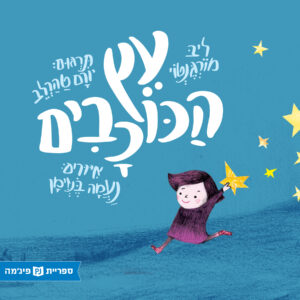 The Tree of Stars
The Tree of Stars 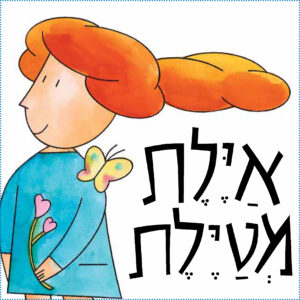 Ayelet Takes a Walk
Ayelet Takes a Walk 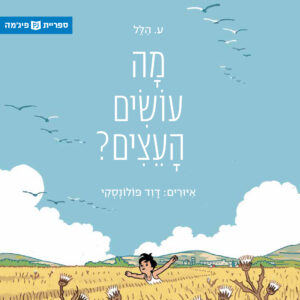 What Do the Trees Do?
What Do the Trees Do? 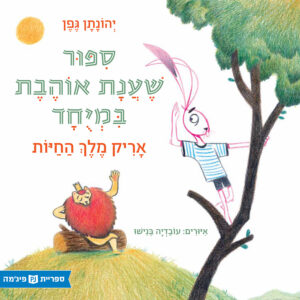 A Story that Anat Especially Likes
A Story that Anat Especially Likes 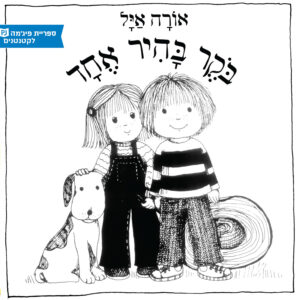 One Bright Morning
One Bright Morning 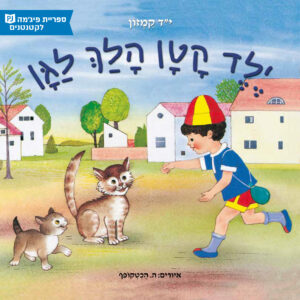 A Young Boy Went to Kindergarten
A Young Boy Went to Kindergarten 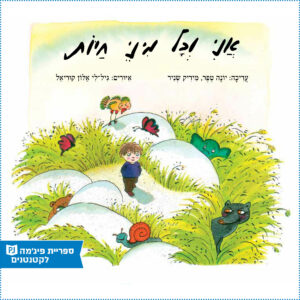 All Kinds of Animals and Me
All Kinds of Animals and Me 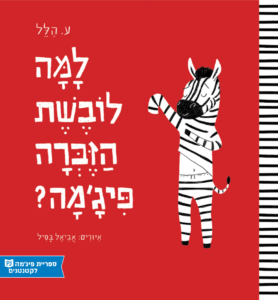 Why is the Zebra Wearing Pajamas?
Why is the Zebra Wearing Pajamas? 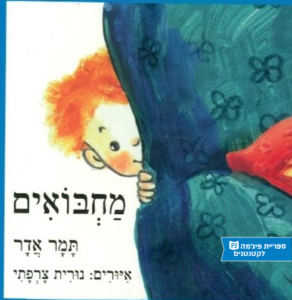 Hide & Seek
Hide & Seek 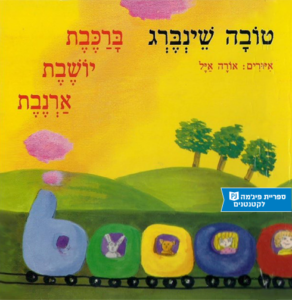 There’s A Rabbit on The Train
There’s A Rabbit on The Train 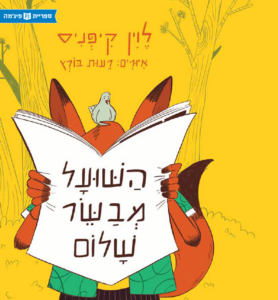 The Fox Announces Peace
The Fox Announces Peace 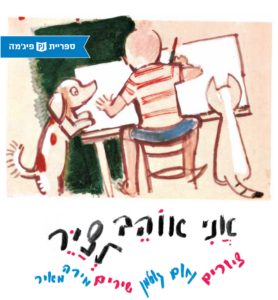 I Love Drawing
I Love Drawing 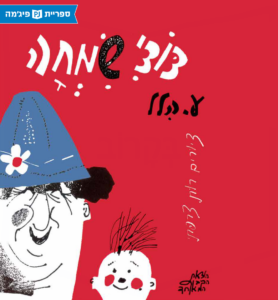 My Uncle Simha
My Uncle Simha 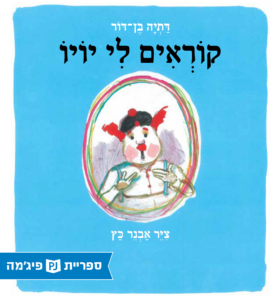 My Name is Yoyo
My Name is Yoyo 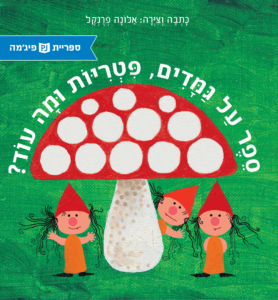 One, Two, Three, What Can a Mushroom Be?
One, Two, Three, What Can a Mushroom Be? 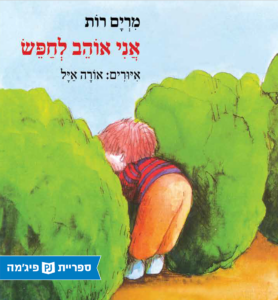 I Like to Look For…
I Like to Look For… 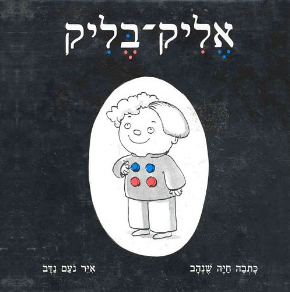 Elik Belik
Elik Belik 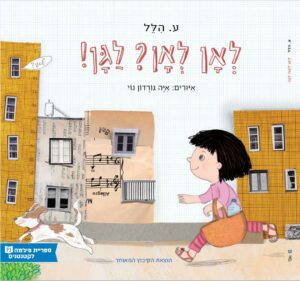 Where to, Where to? To kindergarten!
Where to, Where to? To kindergarten! 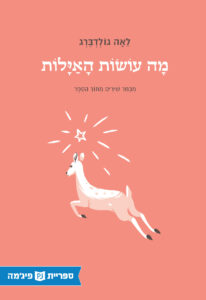 What do the Gazelles Do?
What do the Gazelles Do? 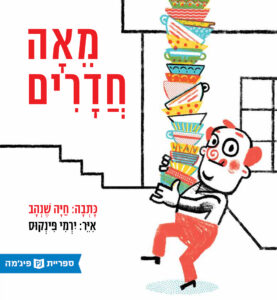 One Hundred Rooms
One Hundred Rooms 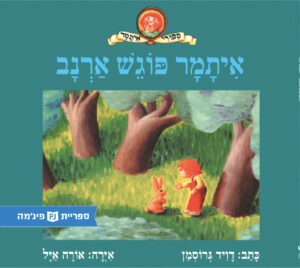 Itamar Meets a Rabbit
Itamar Meets a Rabbit 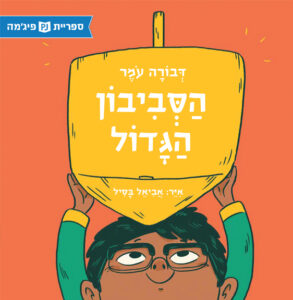 The Big Dreidel
The Big Dreidel 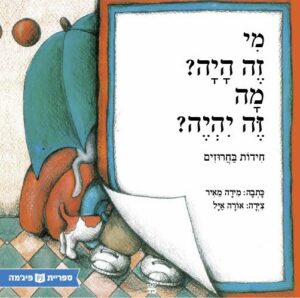 What’s That? What Could it be?
What’s That? What Could it be? 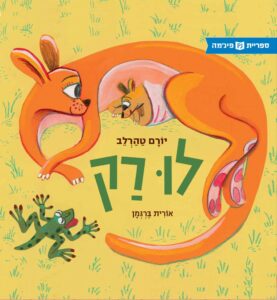 If Only
If Only 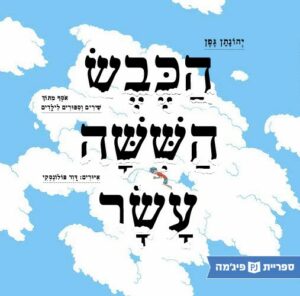 The Sixteenth Sheep
The Sixteenth Sheep 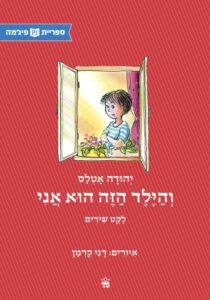 It’s Me
It’s Me 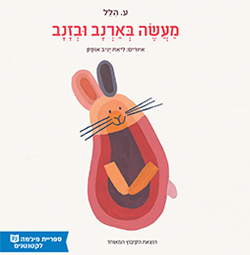 A Tale of a Rabbit and a Tail
A Tale of a Rabbit and a Tail 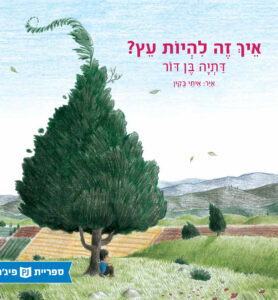 What’s it like to be a Tree?
What’s it like to be a Tree? 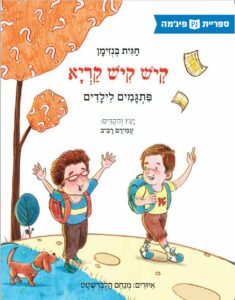 Kish Kish Karya: Proverbs for Children
Kish Kish Karya: Proverbs for Children 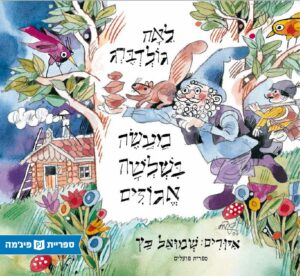 A Tale of Three Nuts
A Tale of Three Nuts 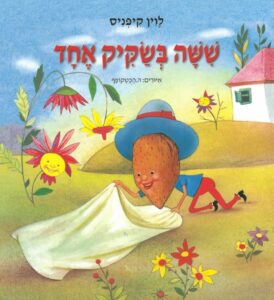 Six in a Bag
Six in a Bag 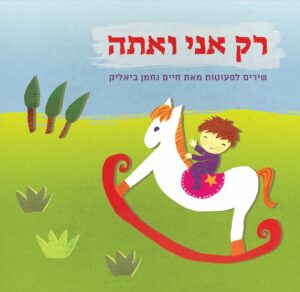 Just You and Me: Songs for Toddlers by Bialik
Just You and Me: Songs for Toddlers by Bialik 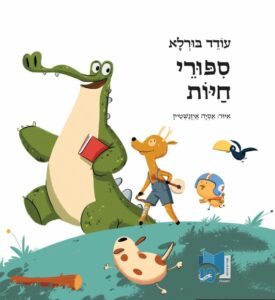 Animal Stories
Animal Stories 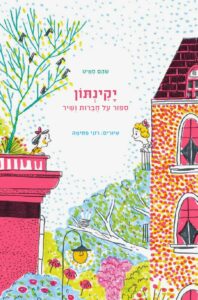 Yakinton: A Story about Friendship and Song
Yakinton: A Story about Friendship and Song 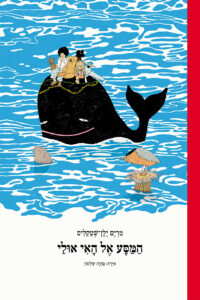 The Journey to the Island of Maybe
The Journey to the Island of Maybe 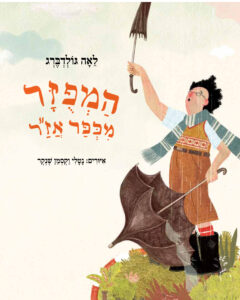 The Scatterbrained Man from Azar’s Village
The Scatterbrained Man from Azar’s Village 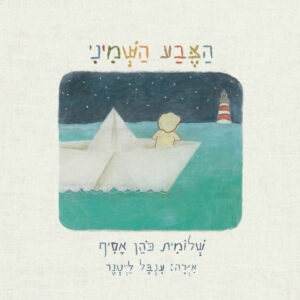 Color Number Eight
Color Number Eight 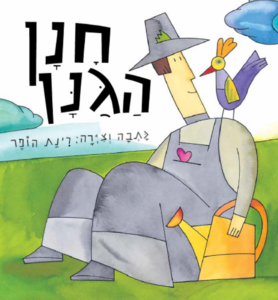 Hannan the Gardener
Hannan the Gardener 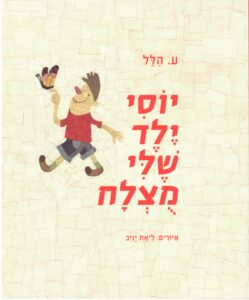 YOSSI, MY WONDERFUL CHILD
YOSSI, MY WONDERFUL CHILD 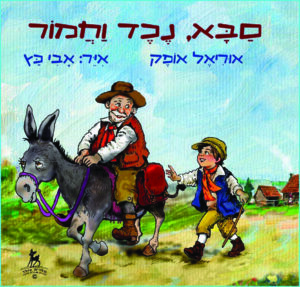 Grandfather, Grandson and a Donkey
Grandfather, Grandson and a Donkey 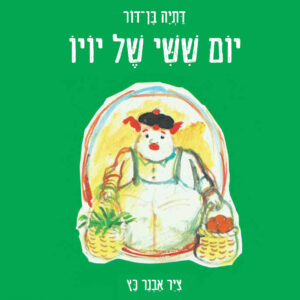 Yo-Yo’s Friday
Yo-Yo’s Friday 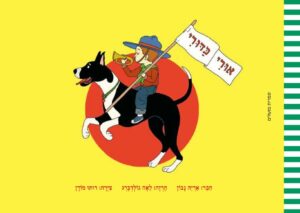 Uri Kadori
Uri Kadori 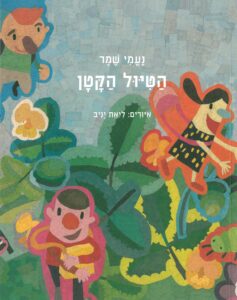 A Short Walk
A Short Walk 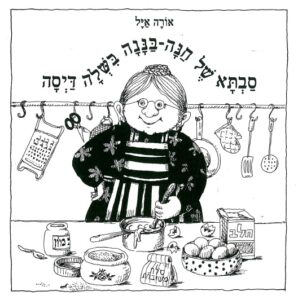 Hannah Banana’s Granny Cooked Porridge
Hannah Banana’s Granny Cooked Porridge 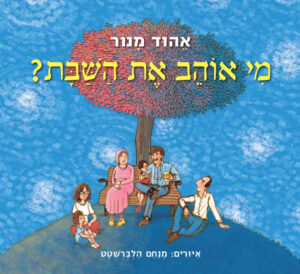 Who Loves Shabbat?
Who Loves Shabbat? 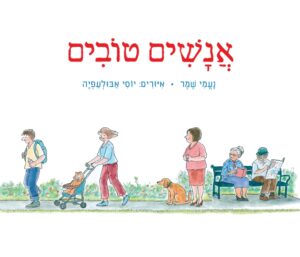 Good People
Good People 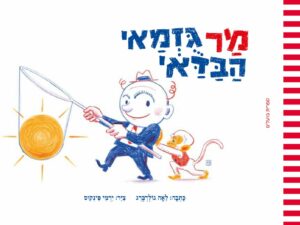 Mr. Fibber the Storyteller
Mr. Fibber the Storyteller 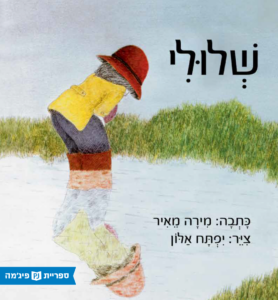 Sheluli
Sheluli 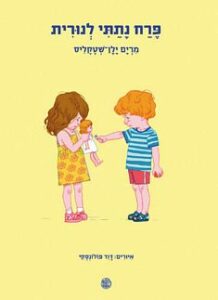 I Gave A Flower to Nurit
I Gave A Flower to Nurit 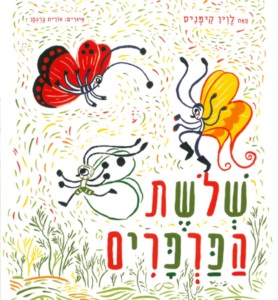 The Three Butterflies
The Three Butterflies 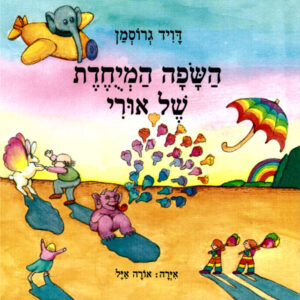 Ury’s Special Language
Ury’s Special Language 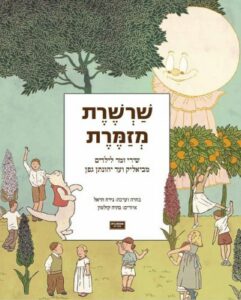 A Singing Chain
A Singing Chain 














